Vegetarian dishes in India embrace a rich tapestry of flavors, showcasing the country's unique culinary prowess. Dal, a staple, features lentils cooked with aromatic spices, while Palak Paneer combines leafy greens with cottage cheese. Aloo Gobi, a comforting potato and cauliflower curry, exemplifies the art of vegetarian cooking. South Indian cuisine offers dosas and idlis, fermented rice and lentil creations served with chutneys and sambar. In Gujarat, Dhokla, a steamed fermented cake, is a popular choice. From street food to elaborate thalis, India's vegetarian offerings celebrate the vibrant array of spices and regional specialties, making vegetarian dining a flavorful and fulfilling experience.
Dosa
-1711623667.jpg)
Dosa, a renowned delicacy, particularly celebrated in South Indian cuisine, is a fermented crepe crafted from a blend of rice and urad dal. This traditional dish boasts a distinct tangy flavor obtained through an overnight fermentation process after soaking and grinding the ingredients into a smooth paste. Accompanied by various sides like sambar, coconut chutney, and tomato chutney, the dosa's thin, crispy exterior and soft interior make it a versatile treat. Embracing diverse fillings like spiced potato masala, paneer, or even cheese for a modern twist, dosa is cooked to a golden-brown perfection on a hot griddle with minimal oil. Its adaptability extends to variations like masala dosa, onion dosa, and dessert dosas filled with jaggery and coconut.
Chutney
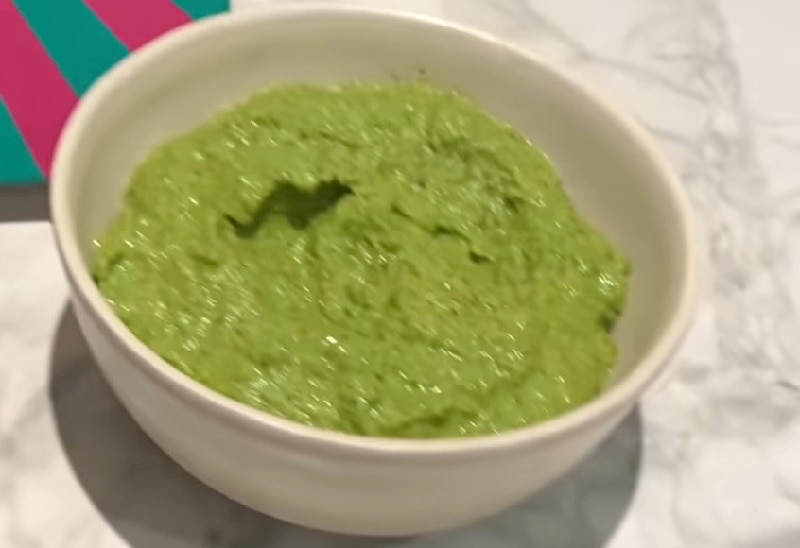
Chutney imparts a burst of tangy and spicy notes to meals, serving as a side dish or condiment and a standalone delight for vegetarians. The array of chutney dishes in India offers diverse flavors and textures. One such favorite is "coriander chutney," featuring fresh coriander leaves, green chilies, garlic, lemon juice, and spices, providing a tangy and refreshing companion to snacks like samosas or pakoras. Another is the "coconut chutney," a creamy blend of fresh grated coconut, green chilies, roasted chana dal, and tempered with mustard seeds, curry leaves, and hing, commonly served with dosas, idlis, or vadas. Additionally, the "tomato chutney" combines sautéed tomatoes with onions, garlic, ginger, and spices, offering a tangy-sweet taste ideal for pairing with rice, chapatis, or sandwiches.
Puri
-1711624481.jpg)
Puri features deep-fried bread crafted from wheat flour, commonly accompanied by various sides. The preparation involves mixing wheat flour with water and salt to create a dough, which is then divided into small balls and rolled into circular shapes. Deep-fried in hot oil, these circles puff up, attaining a golden-brown hue. Typically served with Aloo Sabzi, a spiced potato curry, this combination stands as a favored breakfast or lunch choice in many Indian households. Aloo Sabzi is prepared by cooking potatoes with onions, tomatoes, and a medley of aromatic spices. Puri also pairs well with other accompaniments like Chole (chickpea curry), Dal (lentil soup), or even plain yogurt, offering a diverse and delightful dining experience.
Roti
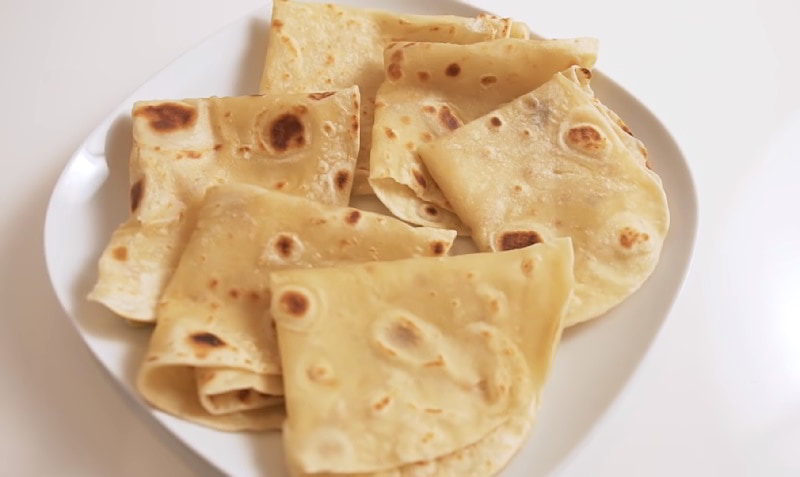
Roti is a type of Indian bread that is typically made from whole wheat flour, water, and sometimes a pinch of salt. Unlike other breads, roti is cooked on a griddle or tawa instead of being baked in an oven. Roti can be enjoyed on its own or paired with various vegetarian dishes. One popular combination is roti with dal, a lentil curry that is rich in protein and essential nutrients. Another common pairing is roti with sabzi, which refers to various vegetable dishes cooked in a flavorful blend of spices. Additionally, roti can be stuffed with different fillings to create delicious variations. For example, aloo paratha is a popular stuffed roti made with a filling of mashed potatoes and spices. Another popular option is paneer paratha, which is filled with a mixture of crumbled cottage cheese, onions, and herbs.
Dal
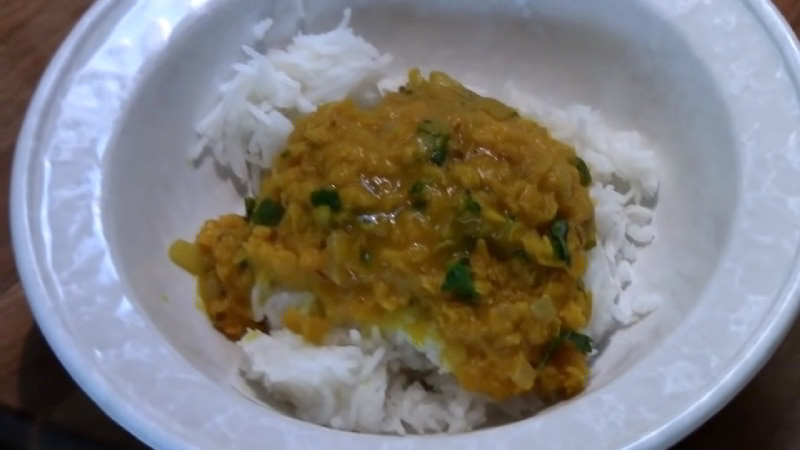
Dal is a delightful dish celebrated for its robust flavors and nutritional richness. Crafted from lentils or pulses, Dal stands as a cornerstone in Indian cuisine, often relished with rice or roti. The preparation involves cooking lentils until they reach a soft, mushy consistency, followed by tempering with an array of spices like cumin, turmeric, mustard seeds, and red chili powder, elevating the taste and aroma. Various versions may incorporate ingredients such as tomatoes, onions, garlic, ginger, and green chilies for additional flavor. Beyond its delectable taste, Dal is a nutritional powerhouse, offering protein, fiber, and essential minerals while remaining low in fat and cholesterol—a wholesome choice for vegetarians. With its versatility, Dal takes on diverse regional variations, exemplified in dishes like Dal Tadka, Dal Makhani, and Sambar. Whether enjoyed as a main course or side dish, Dal stands as a comforting and gratifying vegetarian option cherished in India and worldwide.
Laddu
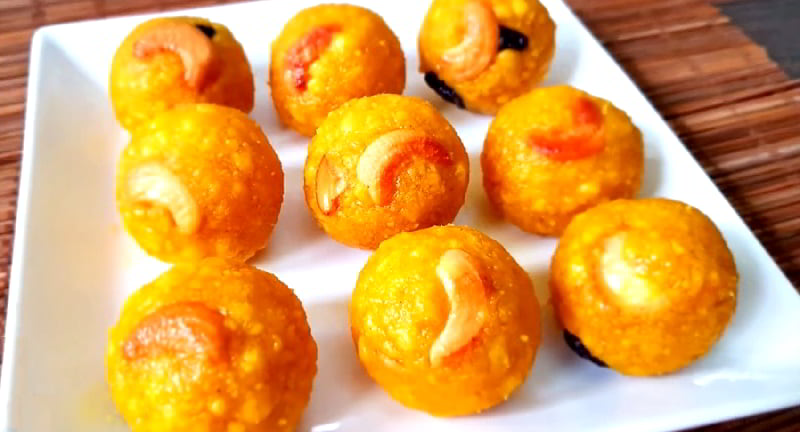
Laddu is a spherical sweet delight crafted from a blend of flour, sugar, ghee (clarified butter), and an assortment of nuts. Laddus typically feature besan (gram flour) or atta (wheat flour), combined with sugar, ghee, and an array of nuts like almonds, cashews, and pistachios. The amalgamation is then shaped into small, bite-sized spheres and adorned with saffron strands or edible silver foil. Often prepared during festive occasions and religious ceremonies as offerings or prasad (blessed food), laddus also serve as a popular sweet accompaniment for tea or a delightful dessert following a meal. Their universal appeal makes laddus a well-loved treat enjoyed across various occasions and preferences.
Chaat
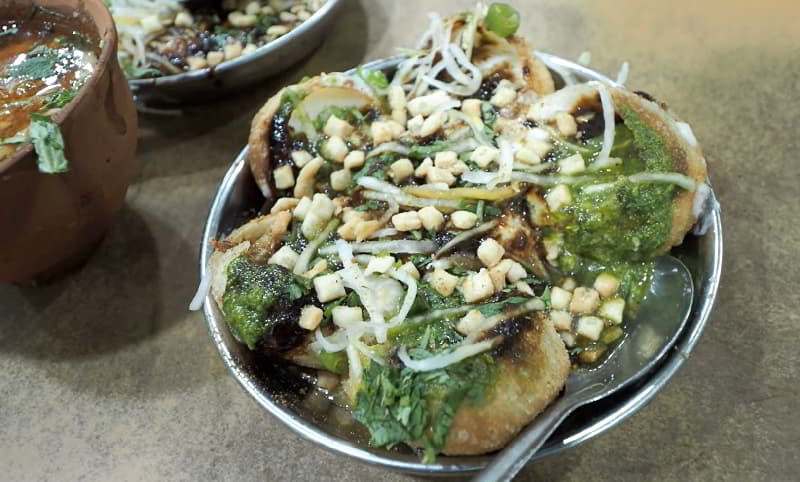
Chaat, a beloved Indian snack, boasts numerous variations all centered around fried dough and a medley of other ingredients. The classic chaat blends potato pieces, chickpeas, crispy fried bread, dahi vada or dahi bhalla (yogurt-soaked lentil dumplings), and a melange of tangy-salty spices. Toppings often include Indian chili, saunth (a tamarind and ginger sauce), fresh coriander leaves, and yogurt. Popular variants like alu tikkis or samosas are adorned with onions, potatoes, peas, and a hint of yogurt. Other favorites such as dahi vada, bhel puri, dahi puri, papri chaat, panipuri, and sev puri offer diverse flavor profiles. Common elements among these delicacies include yogurt, chopped onions, coriander, and sev (thin salty noodles). Chaat masala, a blend of spices like dried mango powder, cumin, Himalayan black salt, coriander, dried ginger, and peppers, adds a distinctive kick. Typically, these ingredients are amalgamated and served on a small metal plate or banana leaf, often fashioned into a bowl.
Kulfi
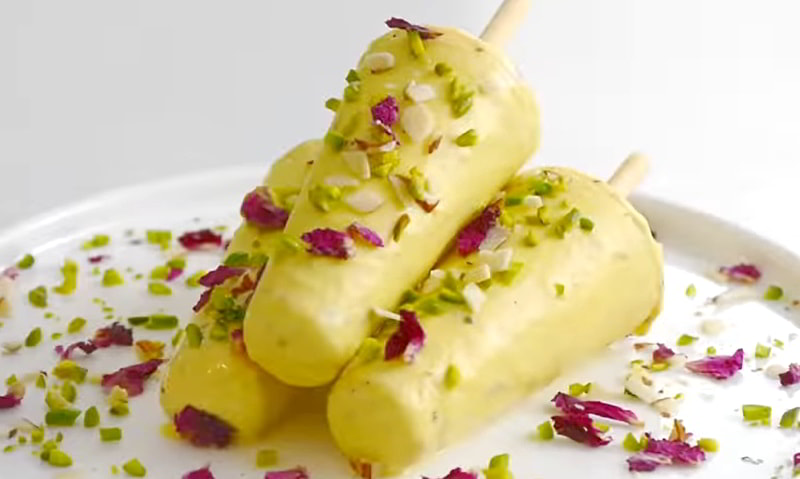
Kulfi is a popular frozen dessert that is loved by people of all ages. The main ingredients of a kulfi include milk, sugar, and a variety of flavorings such as cardamom, saffron, rose water, or pistachios. The milk is simmered on low heat for hours, which helps in reducing its volume and gives it a rich and creamy texture. It is then sweetened with sugar and flavored with the chosen ingredients. Once the mixture is ready, it is poured into small molds or popsicle molds and frozen until firm. The kulfi can be enjoyed as is or garnished with chopped nuts like pistachios or almonds. It is often served on a stick or in a small bowl, making it a perfect treat to beat the heat during summers.
Rasgulla
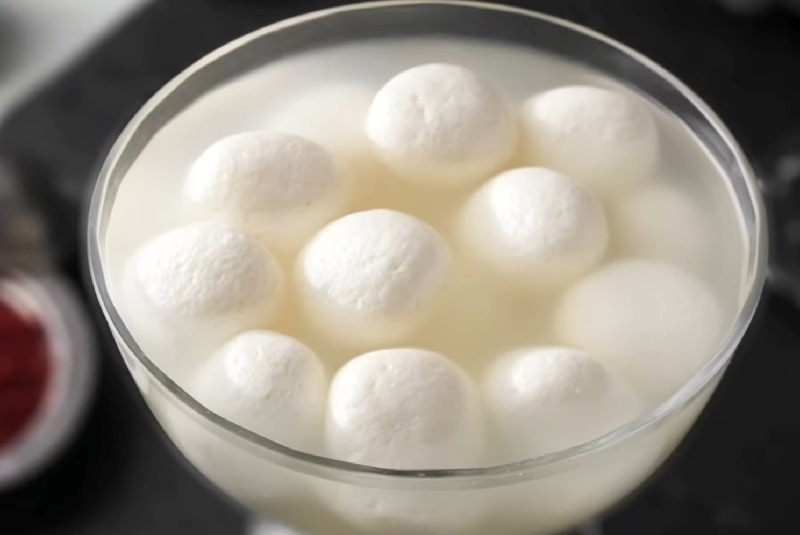
Rasgulla, a well-loved Indian sweet, is crafted from fresh cottage cheese, also known as chenna. The process involves kneading the chenna into a smooth dough, which is then shaped into small balls. These balls are cooked in a sugar syrup until they achieve a soft and spongy consistency. Infused with flavors like cardamom or rose water, the syrup imparts a delightful aroma to the rasgullas. This dessert, adored by all ages, boasts a light and refreshing nature with a soft, melt-in-your-mouth texture—making it an ideal conclusion to any meal. The sweetness of the syrup harmoniously complements the mildness of the chenna, creating a delightful fusion of flavors. Served chilled, rasgulla is a favorite during festive occasions and as a sweet indulgence, gaining popularity not just in India but also worldwide. Beyond its delicious taste, rasgulla stands as a symbol of India's rich culinary heritage.
Saag
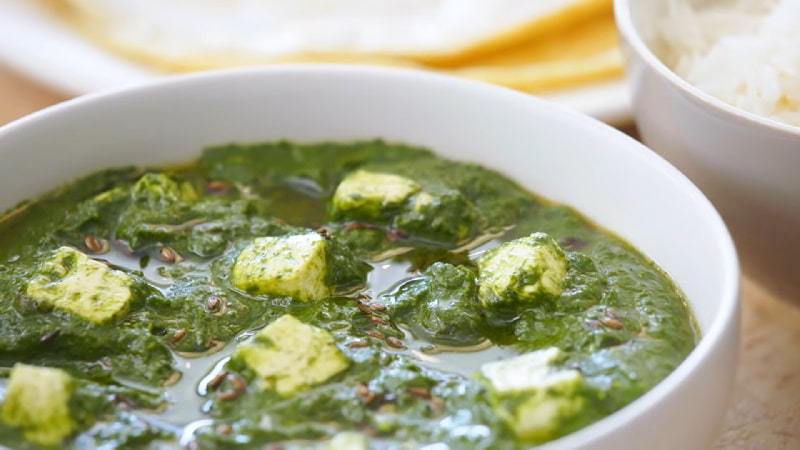
Saag is a vegetable dish, typically composed of leafy greens like spinach, mustard greens, or fenugreek leaves. The greens are blanched, pureed to yield a smooth base, and then combined with aromatic spices and herbs. In a separate pan, a medley of onions, garlic, and ginger is sautéed to a golden brown hue. A symphony of spices, including cumin, coriander, turmeric, and garam masala, is introduced to intensify the dish's flavors. The pureed greens join the pan along with yogurt or cream, imparting a luscious texture. Simmered to perfection, saag becomes a delectable accompaniment to Indian breads like roti or naan or paired harmoniously with steamed rice. This rich and flavorful saag is a culinary delight celebrated for its wholesome and aromatic appeal.
Thali
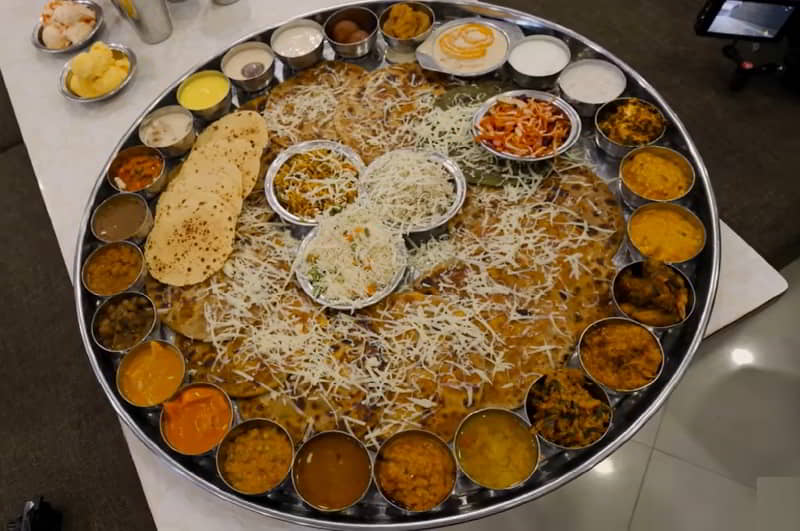
A thali is a complete meal served on a large plate or banana leaf that includes a variety of dishes, giving you a taste of different flavors and textures. The thali typically consists of an assortment of dishes such as dal (lentils), sabzi (vegetable curry), rice, roti (flatbread), raita (yogurt-based side dish), papad (crispy lentil wafers), and pickles. Each dish is carefully prepared with a combination of aromatic spices, herbs, and vegetables, resulting in a harmonious blend of flavors. Some popular vegetarian dishes you can find in a thali include aloo gobi (potatoes and cauliflower curry), paneer tikka (grilled cottage cheese), chana masala (spiced chickpeas), baingan bharta (roasted eggplant curry), and rajma (kidney bean curry). These dishes are not only delicious but also provide a good balance of protein, carbohydrates, and other essential nutrients.
Vada Pav
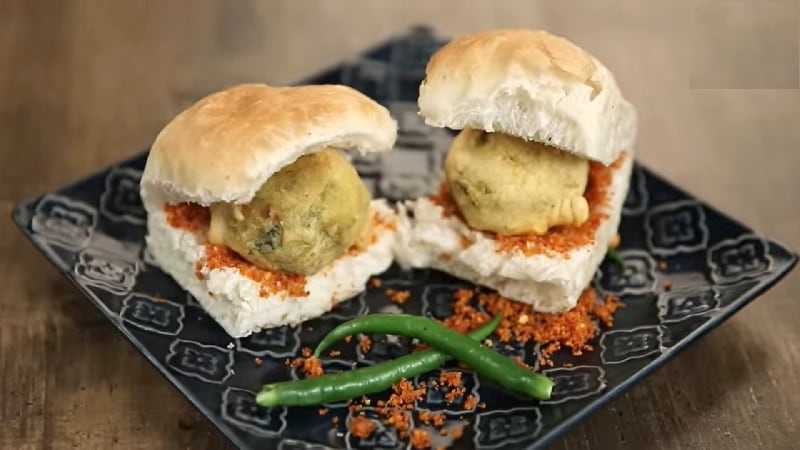
Vada pav, also spelled wada pao, is a popular fast food and a specialty of the Indian state of Maharashtra. This dish features a deep-fried potato dumpling placed inside a partially sliced bread bun (pav). Typically served with one or more chutneys and a green chili pepper, vada pav emerged as an affordable street food in Mumbai, but its popularity has extended to food stalls and restaurants throughout India. It is often referred to as the Bombay burger, acknowledging its roots and its burger-like appearance. This savory delight, with its deep-fried goodness and flavorful accompaniments, has transcended its humble origins to become a widely enjoyed and iconic fast food choice across the country.
Manchurian
-1711649277.jpg)
Manchurian, a beloved Indo-Chinese delight, has gained widespread popularity in India, marrying Indian and Chinese culinary influences. The dish comprises crispy, deep-fried vegetable balls immersed in a zesty and spicy sauce, offering a symphony of flavors. To craft this culinary masterpiece, finely chopped cabbage, carrots, bell peppers, and onions are blended with cornflour, all-purpose flour, and an array of spices. After a plunge into hot oil, the vegetable balls emerge golden and crunchy. The tantalizing sauce is a medley of soy sauce, tomato ketchup, chili sauce, ginger-garlic paste, and other seasonings. Coating the fried delights, the sauce infuses a rich tanginess. Served as an appetizer or main course alongside steamed rice or noodles, Manchurian captivates with its vibrant taste, crunchy texture, and harmonious blend of sweet, spicy, and tangy notes.
Dal Makhani

Dal Makhani, hailing from North India, is an opulent lentil curry crafted from whole black lentils (urad dal) and kidney beans (rajma). It is slow-cooked with aromatic spices, butter, and cream to achieve a decadent and flavorful outcome. The preparation involves soaking the lentils and beans overnight, followed by a gentle cook until they attain a soft and tender texture. These are then melded with a tomato-based gravy, garlic, infused with ginger, and a medley of spices such as garam masala, coriander, and cumin. The curry undergoes a prolonged simmer, allowing the melding of flavors and the lentils to absorb the creamy opulence of butter and cream. Dal Makhani, a staple in Indian households and restaurants, is commonly relished with naan or rice. Its combination of creamy lentils, aromatic spices, and buttery richness renders Dal Makhani a beloved and indulgent classic in India, offering a hearty and satisfying dining experience.
Palak Paneer
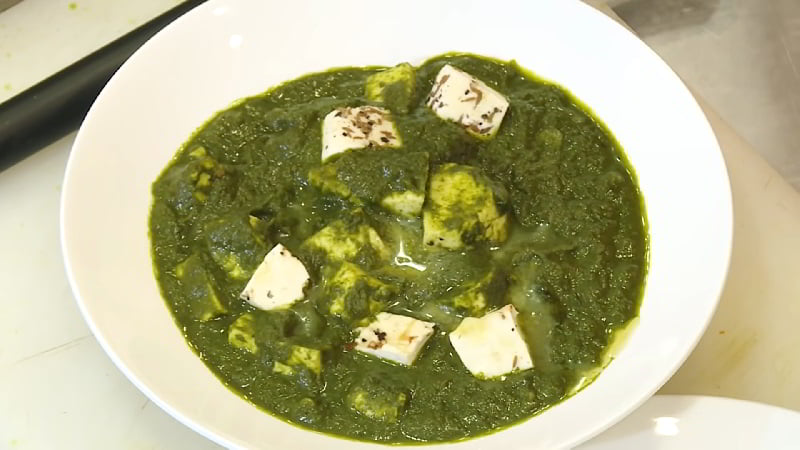
Palak paneer is a popular dish that combines the goodness of spinach (palak) with cottage cheese (paneer). This dish is not only delicious but also highly nutritious. To prepare palak paneer, fresh spinach leaves are blanched and then pureed to create a vibrant green base. In a separate pan, cubes of paneer are lightly fried until golden brown. The paneer is then added to the spinach puree along with a blend of aromatic spices such as cumin, coriander, turmeric, and garam masala. This creates a flavorful and aromatic curry. This dish is typically served with roti (Indian bread) or steamed rice. It is not only a delicious choice for a main course but also a great way to introduce a healthy and nutritious dish into your meal.
Sambar
-1711653169.jpg)
Sambar, a delectable stew originating from South India, is a culinary treasure celebrated for its savory and tangy profile. Comprising a medley of vegetables, lentils, and a distinctive spice amalgamation, it captivates both locals and tourists. To craft sambar, lentils like toor dal or masoor dal are cooked to a soft consistency. Meanwhile, vegetables such as drumsticks, pumpkin, brinjal, and carrots undergo sautéing with aromatic spices like mustard seeds, cumin seeds, fenugreek seeds, and curry leaves. The cooked lentils join forces with tamarind pulp, imparting the dish its unique tanginess. Elevating its flavors, sambar powder, a blend of roasted spices like coriander seeds, dried red chilies, and black peppercorns, is introduced. Typically paired with steamed rice, idli, or dosa, sambar's versatility extends to being enjoyed as a soup or alongside various Indian breads.
Dabeli
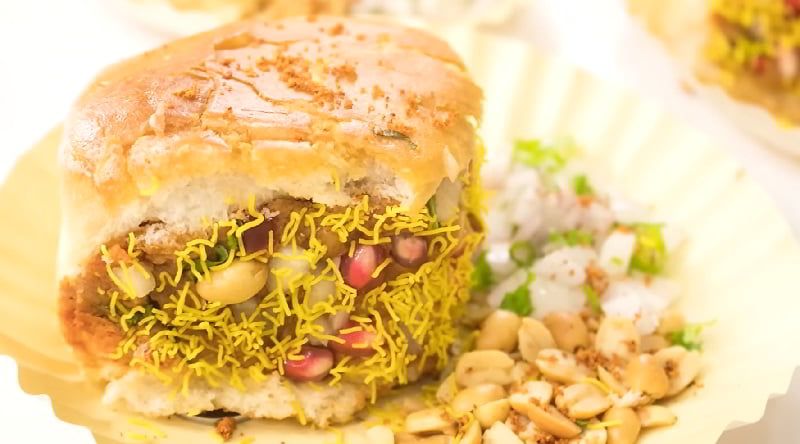
Dabeli, also known as kutchi dabeli or double roti, is a beloved delicacy that combines boiled potatoes with a unique dabeli masala, encased in a ladi pav (burger bun), and complemented by chutneys crafted from garlic, tamarind, red chilies, date, and more. The dish is crowned with garnishes of pomegranate and roasted peanuts, striking a harmonious balance between spiciness and sweetness. Hailing from the Gujarat region, Dabeli has become a popular street food across India, offering a delightful culinary experience that tantalizes taste buds with its rich blend of textures and flavors.
Dhokla
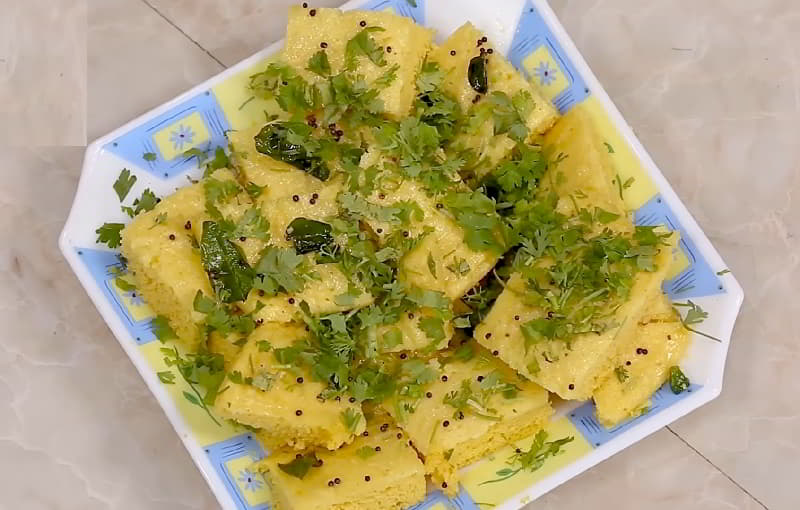
Dhokla, a spongy and savory dish, hails from the Indian state of Gujarat and enjoys widespread popularity throughout the country. Crafted from a fermented batter, this culinary delight is steamed to achieve a cake-like consistency. The batter incorporates a blend of rice and Bengal gram pulse, although variations exist with chickpeas, pigeon peas, or urad beans replacing the gram. Originating in Gujarat but embraced across regions, Dhokla showcases the versatility of Indian cuisine. Its distinctive preparation involves the artful fermentation and steaming process, resulting in a delightful texture and a harmonious blend of flavors. This beloved dish has transcended its regional roots, becoming a cherished part of the culinary landscape, appreciated for its unique taste and cultural significance in Indian cuisine.
Khichdi
-1711667326.jpg)
Khichdi is a one-pot meal that combines rice and lentils, often moong dal or masoor dal, enriched with various spices and vegetables. The key ingredients, lentils, contribute significant protein and fiber, while rice provides satisfying carbohydrates. Cumin, turmeric, and coriander intensify the flavor, imparting not only taste but also health benefits like aiding digestion, boosting immunity, and possessing anti-inflammatory properties. Khichdi is commonly accompanied by yogurt or pickle for a tangy twist. Adaptable to personal preferences, it can incorporate vegetables like peas, carrots, or potatoes.
Peda
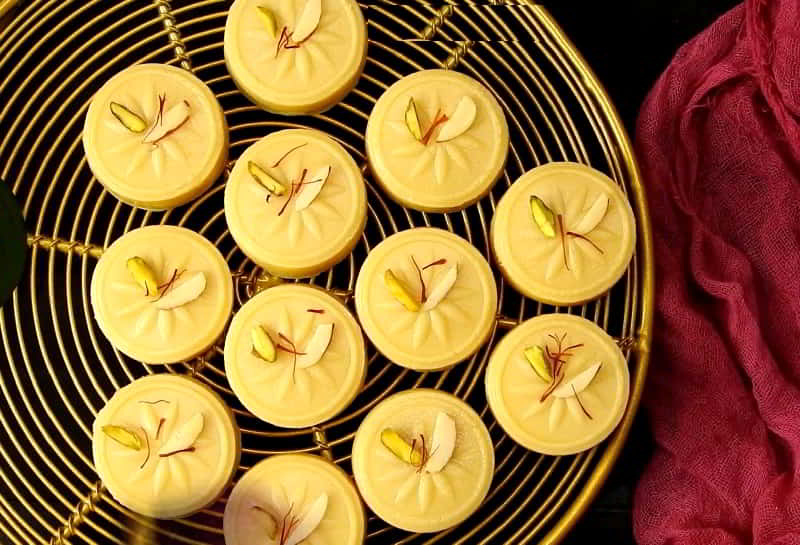
Peda, originating from the vibrant city of Mathura in Uttar Pradesh, India, is a cherished sweet delicacy. These delectable treats are crafted into thick, semi-soft round balls, embodying a delightful combination of khoa (milk solids), sugar, and aromatic cardamom seeds for traditional flavoring. With a rich brown color, each Peda promises a burst of sweetness and warmth. This iconic dessert is often enjoyed during festive occasions, religious celebrations, and as a token of love and hospitality. Its simplicity belies its exquisite taste, making it a favorite among sweet connoisseurs across the country. Whether savored as a standalone indulgence or paired with a cup of chai, Peda remains a timeless delight, capturing the essence of Indian culture and culinary heritage.
Khandvi
-1711667840.jpg)
Khandvi is a renowned savory delight crafted from a blend of gram flour (besan), yogurt, and spices. The batter is skillfully spread thinly, rolled tightly into cylindrical shapes, steamed, and then cut into bite-sized pieces. What sets Khandvi apart is its exceptional texture, akin to a delicate crepe, soft and silky. The flavor profile offers a delightful combination of tanginess and subtle spiciness, complemented by a touch of sweetness from the tempering of mustard seeds, curry leaves, and green chilies drizzled on top. This popular Gujarati snack showcases a harmonious fusion of textures and tastes, making it a cherished culinary creation celebrated for its unique qualities.
Khaja
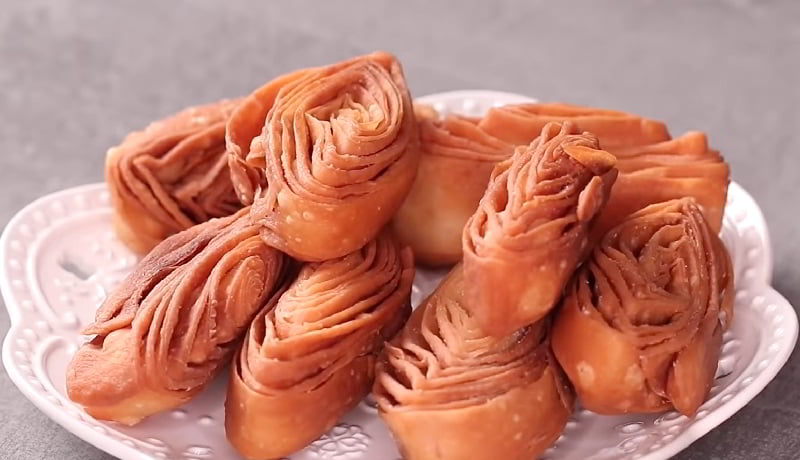
Khaja is a sweet and crispy dessert that originated in the Indian subcontinent and is particularly popular in regions like Odisha, Bihar, and Andhra Pradesh. It is made by kneading wheat flour or all-purpose flour into a dough, which is then rolled out into thin layers. The layers are folded, creating a flaky texture, and the dough is deep-fried until golden brown. After frying, the khajas are often soaked in sugar syrup to add sweetness and moisture. Khaja can have various variations, with some recipes incorporating sesame seeds, cardamom, or other flavorings. This delectable treat is commonly enjoyed during festivals, celebrations, and special occasions, offering a delightful combination of crispiness and sweetness that appeals to the taste buds.
Bhel Puri
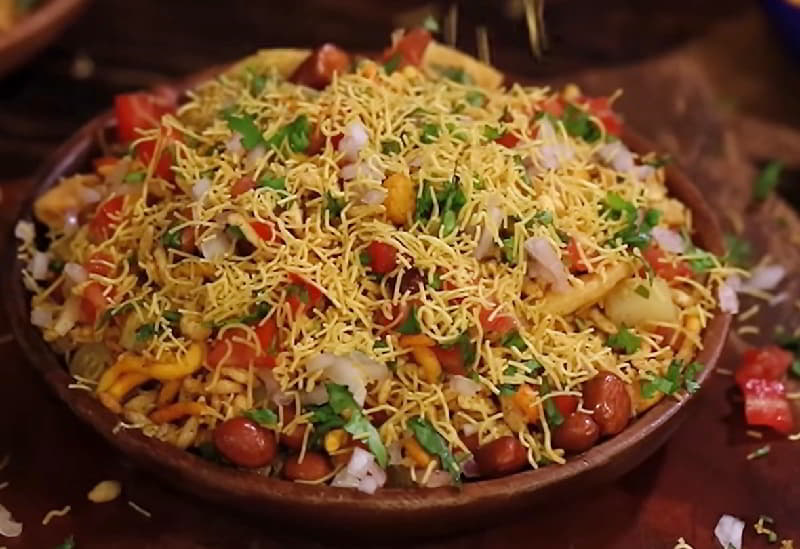
Bhel puri is a popular street food snack celebrated for its vibrant flavors and textures. This savory dish combines puffed rice, crispy fried noodles (sev), chopped onions, tomatoes, and an array of chutneys and spices. In the preparation, puffed rice and sev are mixed with finely chopped onions and tomatoes, creating a delightful medley. Tangy tamarind chutney, spicy green chutney, and a splash of lemon juice infuse the mixture with flavor. A blend of spices like chaat masala and red chili powder further elevates the taste profile. Bhel puri is renowned for its unique combination of crunchiness from puffed rice and sev, freshness from onions and tomatoes, and a delightful interplay of sweet, spicy, and tart flavors from chutneys and spices.
Puran Poli
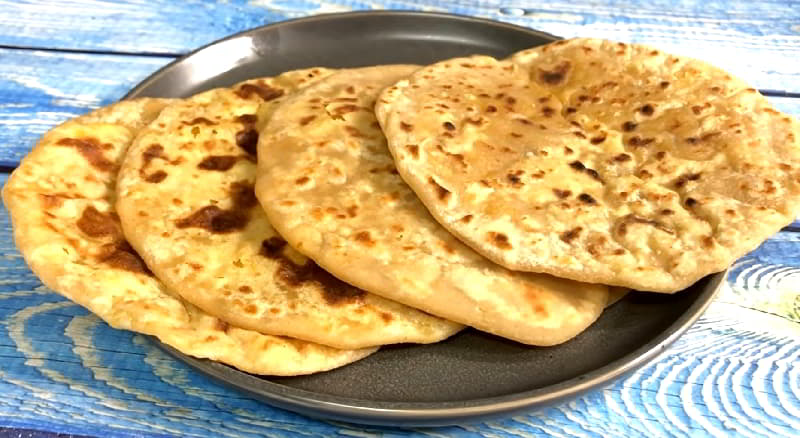
Puran poli, a delectable sweet flatbread, boasts a rich tapestry of variations. Its essence lies in a medley of ingredients such as jaggery or cane sugar, senaga pappu, ghee, plain flour, and cardamom or nutmeg powder, combined with water. This delightful treat reflects a fusion of culinary influences. Gujarat's rendition incorporates pigeon pea, while Karnataka and Tamil Nadu lean towards their own interpretations. In Andhra Pradesh, pesara pappu or a combination with chickpea might be used. To enhance its taste, nuts, dates, and turmeric powder can be included, lending nuanced layers of flavor. Puran poli, relished in diverse forms, epitomizes the unique culinary nuances of each region, blending ingredients to craft a sweet harmony. It serves as a cultural emblem, pleasing palates with its distinctive textures and flavors that vary across the vast landscapes of India.
Dal Bhat
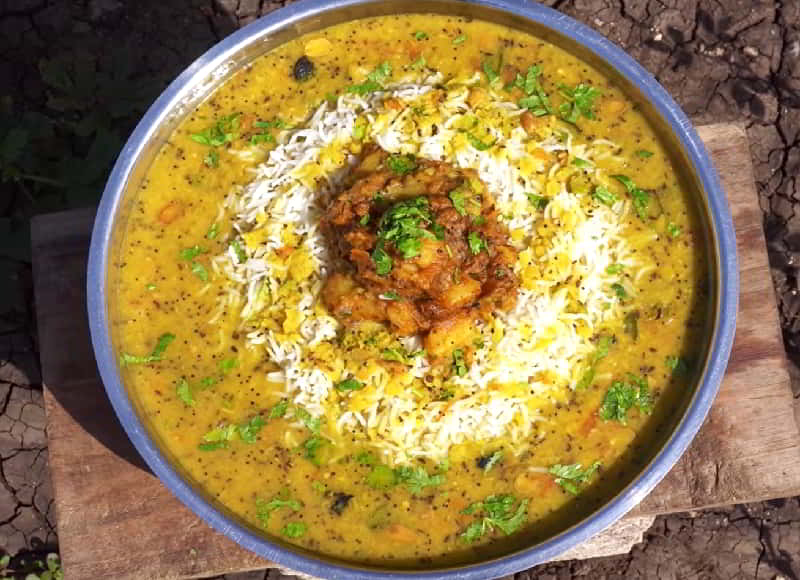
Dal Bhat, a staple dish, consists of lentils and rice. Lentils, known as dal, are cooked to a creamy consistency and seasoned with an array of spices such as turmeric, cumin, and coriander. The choice of lentils can vary, including red lentils, yellow lentils, or split peas. Bhat refers to rice, cooked separately and served alongside the dal. Rice can be plain or flavored with spices like cardamom, cloves, and cinnamon. Completing the meal are various accompaniments, such as sautéed spinach, cauliflower curry, or potato masala as vegetable sides. Additionally, it's common to serve a dollop of yogurt, pickle, and papad, a crispy flatbread, alongside. This flavorful and satisfying combination of lentils, rice, and accompaniments makes Dal Bhat a beloved dish enjoyed across regions for its nourishing qualities and delightful flavors.
Rasam
-1711670300.jpg)
Rasam, a vibrant South Indian soup-like dish, is celebrated for its explosion of flavors. Its tangy base, varying across regions, features ingredients like vate huli, kokum, tamarind, ambula, malabar tamarind (kudam puli), or amchur stock. While not obligatory, some recipes include dal or lentil stock, commonly sourced from split yellow pigeon peas or mung beans. The seasoning blend encompasses a rich array of spices such as curry leaves, black pepper, turmeric, jaggery, cumin, tomato, garlic, lemon, mustard seeds, shallots, chili powder, and coriander leaves, lending depth and complexity to the concoction. Rasam's adaptability permits diverse interpretations, each reflecting South India's distinct culinary heritage, captivating palates with its spicy, tangy, and aromatic essence.
Undhiyu
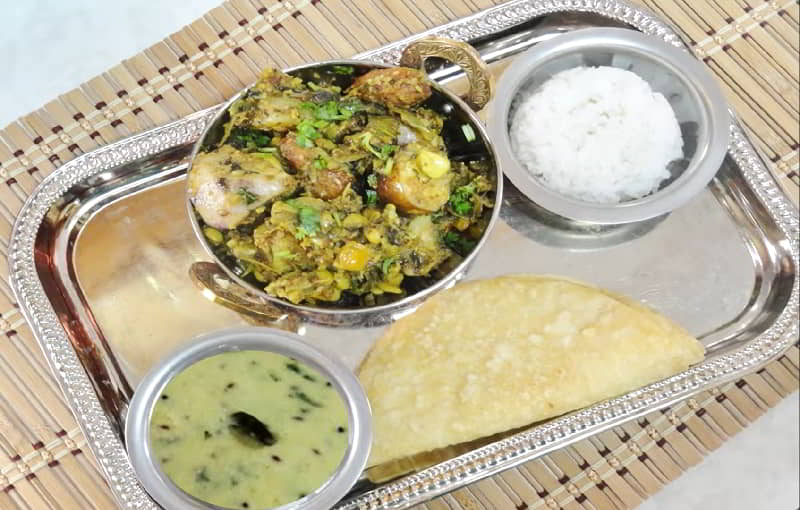
Undhiyu hails as a regional specialty from Surat, Gujarat, India. This mixed vegetable dish boasts a colorful array of ingredients, including unripe banana, green beans or new peas (often with their tender pods), small eggplants, purple yam, muthia (dumplings or fritters made from fenugreek leaves and spiced chickpea flour or handva no lot), potatoes, and sometimes plantain. These vegetables are seasoned with a dry curry paste featuring green chili pepper, garlic, cilantro leaves, ginger, and a hint of sugar, occasionally enriched with freshly grated coconut. The slow cooking process, aided by a touch of vegetable oil and minimal water, ensures that the root vegetables steam to perfection, infusing the dish with layers of complex flavors and textures emblematic of Gujarati cuisine's rich culinary heritage.
Mattar Paneer
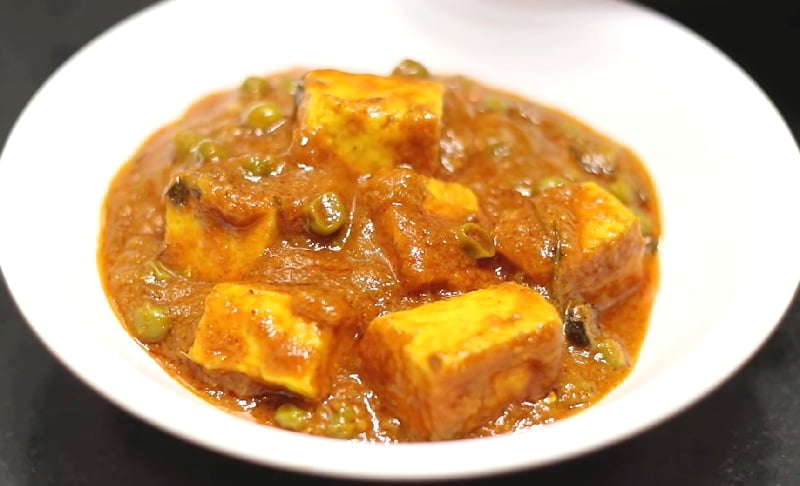
Matar paneer is a beloved Indian dish that combines the richness of paneer (Indian cottage cheese) with the sweetness of green peas (matar). This delectable curry is made by cooking paneer and peas in a tomato-based gravy infused with aromatic spices. To prepare matar paneer, the paneer is first lightly fried until golden brown, giving it a slightly crispy texture. It is then simmered in a flavorful tomato sauce that is spiced with a variety of Indian spices such as cumin, coriander, turmeric, and garam masala. The addition of ginger and garlic enhances the overall taste and adds a hint of warmth to the dish. The green peas add a burst of freshness and sweetness to the curry, balancing out the rich and creamy paneer. The dish is typically garnished with fresh coriander leaves and served with steamed basmati rice or hot rotis.
Shahi Paneer
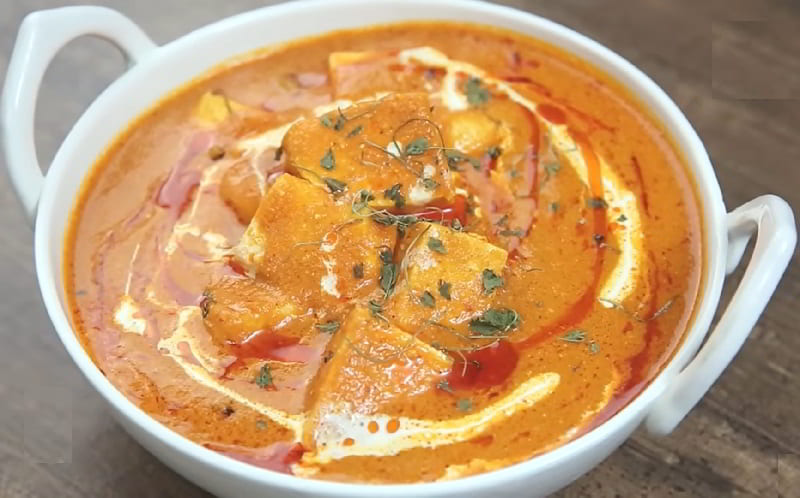
Shahi paneer, also popular as Raajsi Chhena, Paneer Rajwadi, or Chhena Rajwadi, is a luscious dish, featuring chhena or paneer in a rich, creamy gravy infused with tomatoes and spices. To prepare this royal delight, a curry is crafted by blending tomatoes, ground cashews, clarified butter, cream, and onions, complemented by chhena/paneer cubes and an array of spices. The amalgamation of these ingredients creates a velvety texture and a harmonious blend of flavors. Typically enjoyed with traditional tawa roti or tandoori roti (Indian flatbreads), as well as rice and bread, Shahi paneer is a regal culinary creation. The terms Chhena and Paneer denote Indian cottage cheese, while Rajwadi and Shahi signify the royal essence of this delectable dish.
Bhakri
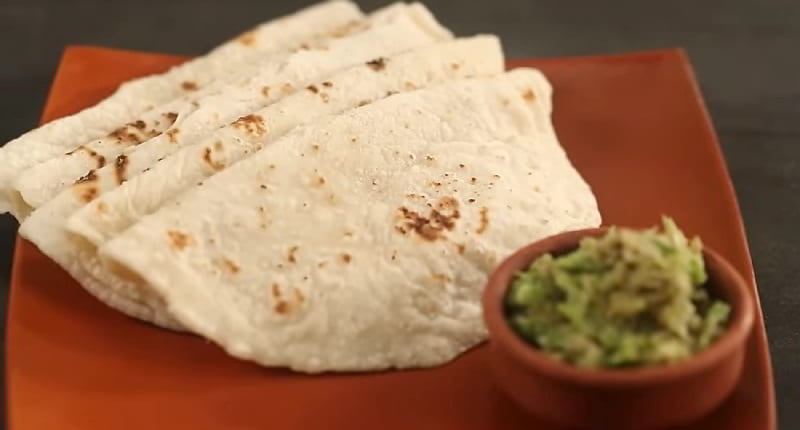
Bhakri, a round flatbread prevalent in Gujarat, Maharashtra, Rajasthan, and Karnataka in India, distinguishes itself with coarser textures compared to regular wheat chapatis. Crafted from jowar or bajra, bhakri can vary in softness or hardness, differing from khakhra in terms of texture. To prepare, a stiff dough is kneaded with flour, salt, and hot water, divided into small balls, and flattened by pressing with palms. Cooking on a heated tava involves water application, finger spreading, and direct flame roasting. Bhakri's versatile nature allows for soft or hard variants, with the latter possessing a satisfying crunch. Typically served with baingan bharta, yogurt, pithla, garlic chutney, thecha, or green leafy vegetables, it once served as a rural staple for breakfast and lunch in fields, even doubling as a plate for chutneys or kharda. In regions like Khandesh, bhakri paired with shev bhaji is popular, while in coastal areas like Konkan and Goa, rice flour bhakris accompany fish curry.
Aloo Paratha
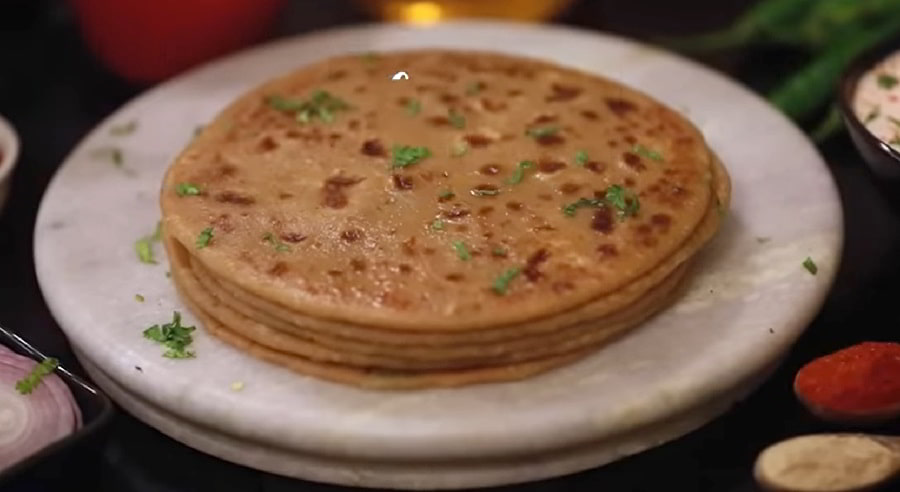
Aloo Paratha is a delectable and hearty flatbread cherished by individuals of all ages. This culinary delight features a soft dough made by kneading wheat flour, water, and a pinch of salt. The dough is rolled into small circles and filled with a spiced mashed potato mixture, incorporating aromatic spices like cumin, coriander, turmeric, and red chili powder. Carefully rolled out into round shapes, the stuffed dough is cooked on a tawa until achieving a golden brown, crispy texture. Served hot, Aloo Paratha is often adorned with a dollop of butter or ghee. It pairs splendidly with yogurt, pickles, or a side of spicy tomato chutney. Beyond its deliciousness, Aloo Paratha is nutritious, combining the goodness of whole wheat flour and potatoes. This versatile dish is a popular choice for breakfast, lunch, or dinner, delighting taste buds across the nation with its perfect blend of flavors and textures.
Far Far
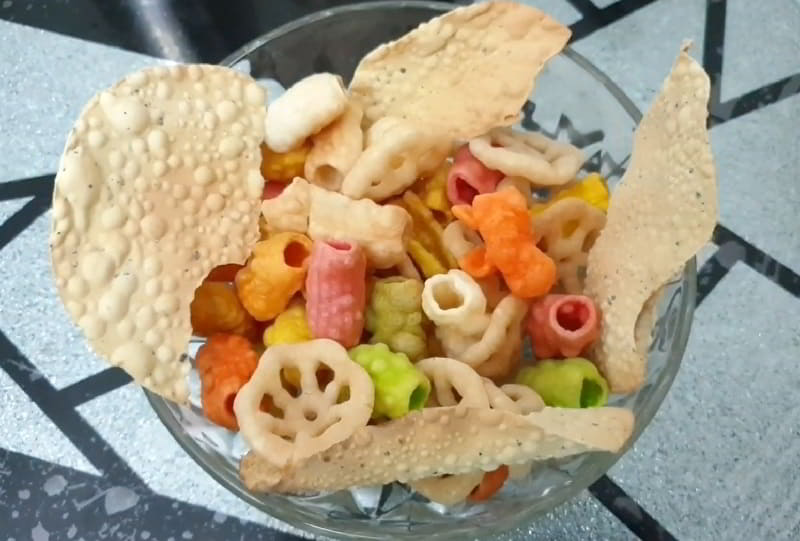
Far-far stands out as an Indian snack crafted mainly from potato starch and tinted sago, possibly incorporating tapioca and wheat flour. These delightful treats exhibit a unique characteristic, puffing up instantly when deep-fried. Enjoyed either as a standalone snack or served akin to papadum, they provide a delightful accompaniment to meals. Far-far comes in an array of colors and shapes, ranging from stars and hollow tubes to flat squares, gears, aeroplanes, and various animal shapes. This diverse presentation adds a playful touch to the culinary experience, making far-far not just a flavorful treat but also a visually appealing and versatile addition to the snack repertoire in Indian cuisine.
Bombay Mix
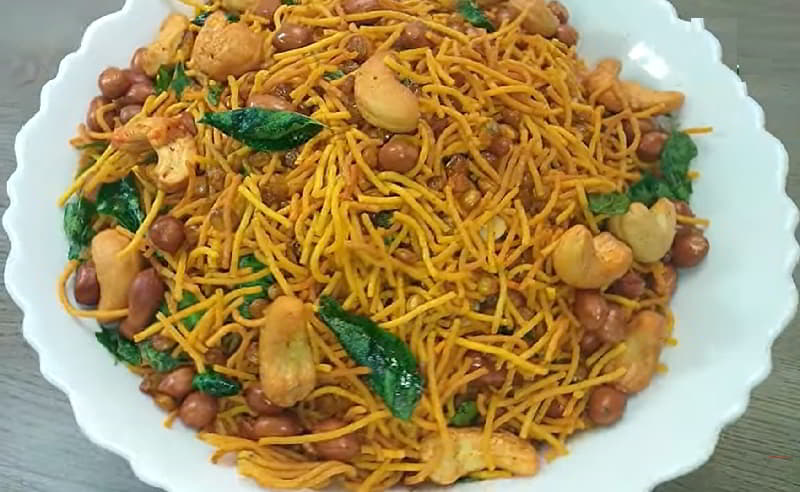
Bombay mix, also known as chanachur, is a snack mix with a diverse blend of spicy dried ingredients. This delectable mix incorporates vegetable oil, curry leaves chickpea flour ganthiya, fried lentils, corn, chickpeas, puffed rice, fried onion, and peanuts. The array of ingredients is seasoned with salt and a harmonious blend of spices, potentially featuring mustard seeds and coriander. The result is a flavorful and crunchy snack that tantalizes taste buds with a fusion of textures and tastes. Whether enjoyed as a quick bite or a savory accompaniment, Bombay mix showcases the rich tapestry of Indian flavors, making it a popular and beloved namkeen choice across the country and beyond.
Manchow Soup
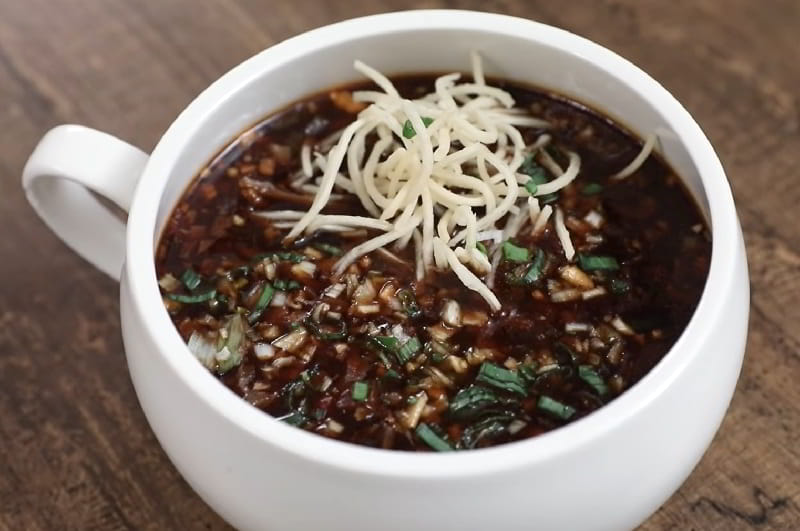
Manchow soup is a flavorful soup that is a perfect blend of Chinese and Indian flavors, making it a favorite among food lovers. The base of Manchow soup is made with a combination of vegetables like carrots, scallions, cabbage, bell peppers, and mushrooms, which are stir-fried in aromatic spices like ginger, garlic, and green chilies. To enhance the taste, soy sauce and vinegar are added, giving it a tangy and slightly spicy flavor. What sets Manchow soup apart is the addition of crispy noodles. These noodles are deep-fried until golden and then added to the soup just before serving, adding a delightful crunch to each spoonful. Some variations of Manchow soup also include the addition of tofu or paneer for added protein. The soup is typically garnished with fresh cilantro and spring onions, giving it a vibrant and appetizing appearance. It is served hot and can be enjoyed as an appetizer or as a light meal on its own.
Banana Fritter

Banana fritters, also known as "Pazham Pori" in South India, are a cherished treat that's both simple to prepare and delightful to savor. This traditional Indian snack involves dipping ripe bananas into a batter composed of sugar, flour, and a dash of cardamom or other spices, then frying them until they turn a lovely golden hue. The natural sweetness of ripe bananas adds to their appeal, while the batter lends a delicate, crispy texture. The addition of cardamom or spices imparts a fragrant aroma that beautifully complements the bananas' sweetness. These fritters are often enjoyed during tea-time or as a dessert following a meal, either on their own or alongside a steaming cup of tea or coffee. For an extra touch of sweetness, they can be served with coconut chutney or a dusting of powdered sugar. Loved by people of all ages, banana fritters hold a special place in the hearts and homes of many Indian families.
Panjiri
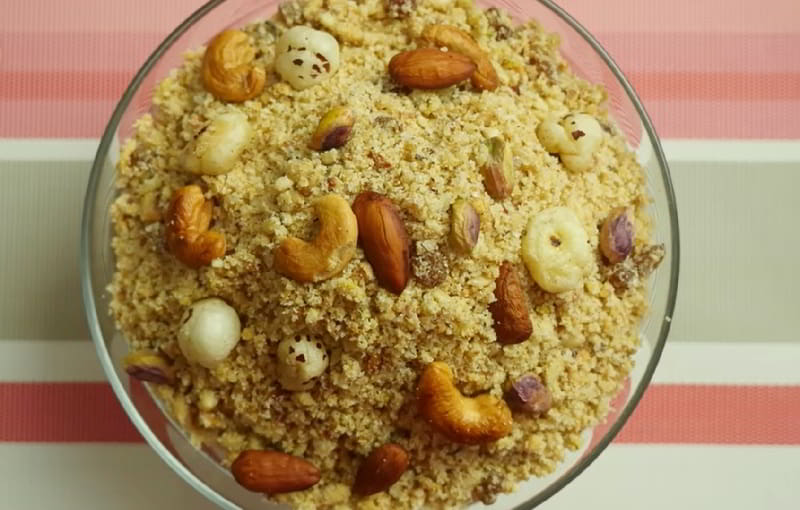
Panjiri is a traditional Indian sweet dish that is often prepared during special occasions, festivals, or as a nutritious postpartum treat for new mothers. It is especially popular in North India and Punjab. The main ingredients of panjiri include whole wheat flour (atta), ghee (clarified butter), sugar, and a variety of nuts and dried fruits such as almonds, cashews, pistachios, raisins, and dried coconut. Additionally, spices like cardamom and nutmeg are often added to enhance the flavor. To prepare panjiri, the whole wheat flour is roasted in ghee until golden brown, giving it a nutty flavor. Then, sugar and the chopped nuts and dried fruits are added and mixed thoroughly. Finally, spices are added for fragrance and flavor. Panjiri is known for its high nutritional value and is believed to provide warmth and energy, making it especially popular during the winter months. It is often consumed as a snack or dessert and is also given to new mothers to aid in their recovery after childbirth.
Bakarwadi
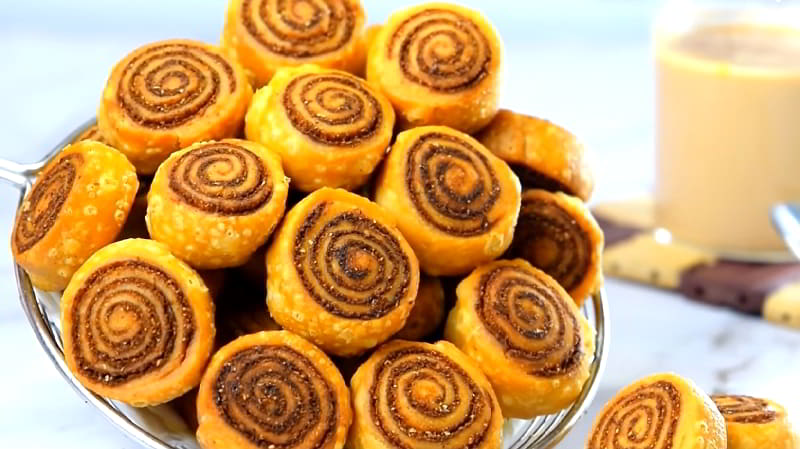
Bakarwadi is a beloved traditional snack renowned for its crispy texture and sweet-spicy flavor, particularly cherished in Gujarat and Maharashtra. Crafted from a dough of gram flour, this delicacy is rolled into spirals and stuffed with a tantalizing mixture of coconut, poppy seeds, and sesame seeds. Once assembled, these savory spirals are deep-fried to golden perfection until achieving a satisfying crunch. Notably, Bakarwadi boasts a remarkable shelf life, allowing it to be stored for weeks without compromising its taste and texture. This enduring quality makes it an ideal choice for an indulgent evening snack, enjoyed by individuals of all ages. Whether savored alone or shared among friends and family, Bakarwadi remains a quintessential part of culinary traditions in both regions, delighting taste buds with its irresistible blend of flavors and textures.
Baingan Bharta
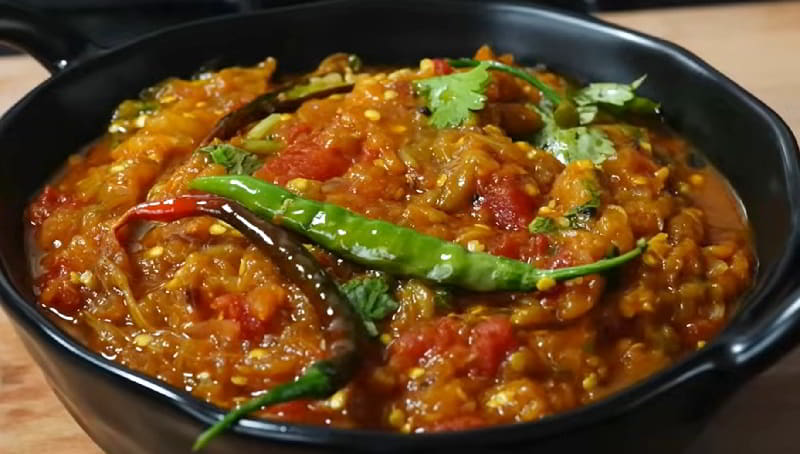
Baingan bharta is a delectable dish made using roasted eggplant (baingan). To prepare baingan bharta, the eggplant is first roasted until the skin is charred and the flesh becomes soft and tender. Once cooled, the skin is peeled off and the pulp is mashed. In a separate pan, onions, tomatoes, and spices like cumin, coriander, turmeric, and red chili powder are sautéed until fragrant and cooked through. The mashed eggplant is then added to this mixture and cooked together, allowing the flavors to blend and intensify. The result is a rich and smoky dish with a creamy texture. Baingan bharta is often garnished with fresh coriander leaves and served with roti (Indian bread) or rice. It can be enjoyed as a main course or as a side dish, and its versatility makes it a favorite at dinner tables across India.
Kadhi
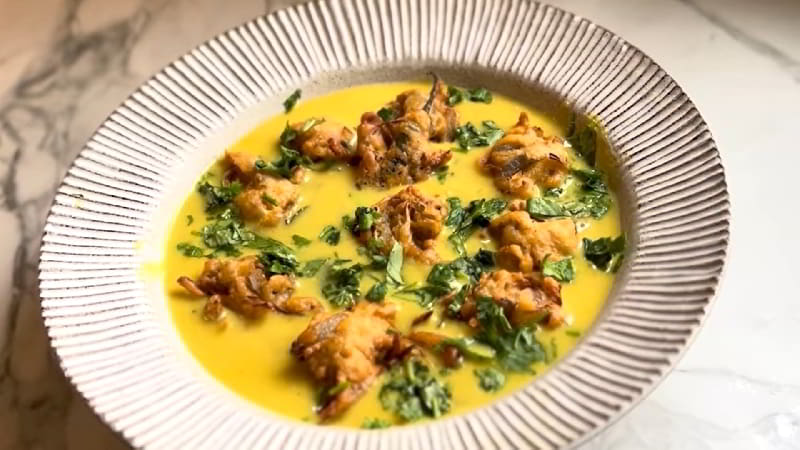
Kadhi is a yogurt-based gravy renowned for its tangy and slightly spicy profile. Typically paired with steamed rice or Indian breads like roti or puri, this flavorful dish involves combining yogurt with besan (gram flour) and an array of spices. To prepare kadhi, the mixture is cooked until it thickens, creating a creamy texture. Simultaneously, a tempering of mustard seeds, cumin seeds, fenugreek seeds, dried red chilies, and curry leaves imparts a fragrant and aromatic essence to the dish. Some variations incorporate vegetables like okra or pakoras (deep-fried fritters) for added texture and flavor. Kadhi stands out for its comforting appeal, often garnished with fresh cilantro leaves, offering a delightful and hearty meal experience.
Basundi
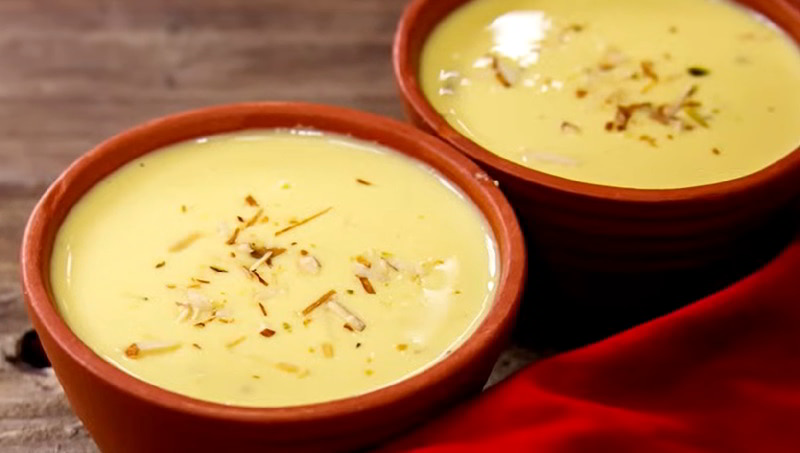
Basundi is a rich and creamy delicacy, crafted from thickened milk, and sugar, and adorned with the aromatic essence of cardamom and saffron. The preparation involves simmering whole milk over an extended period, ensuring reduction and thickening through continuous stirring to prevent sticking. The sweetening process introduces sugar as the milk gradually transforms. The infusion of cardamom powder elevates its aroma, while saffron strands contribute to a golden hue. Traditionally served chilled, Basundi stands alone as a delectable dessert or serves as a delightful accompaniment to other sweets like puri or chapati. Its visual allure is enhanced with slivered almonds, pistachios, and occasionally, the delicate touch of rose petals.
Murabba

Murabba is a traditional Indian delicacy made by preserving fruits or vegetables in sugar syrup. To prepare murabba, fruits or vegetables such as apples, mangoes, gooseberries (amla), or carrots are typically used. The chosen fruit or vegetable is cooked in a sugar syrup flavored with spices such as cardamom, saffron, or rose water until it becomes soft and translucent. The syrup is often infused with additional flavors to enhance the taste. Once the fruit or vegetable is fully cooked and infused with the syrup, it is left to cool and stored in sterilized jars. Murabba can be enjoyed on its own as a sweet treat or served as a condiment alongside meals. It is cherished not only for its delightful taste but also for its long shelf life, making it a popular homemade preserve in many Indian households.
Avil Milk
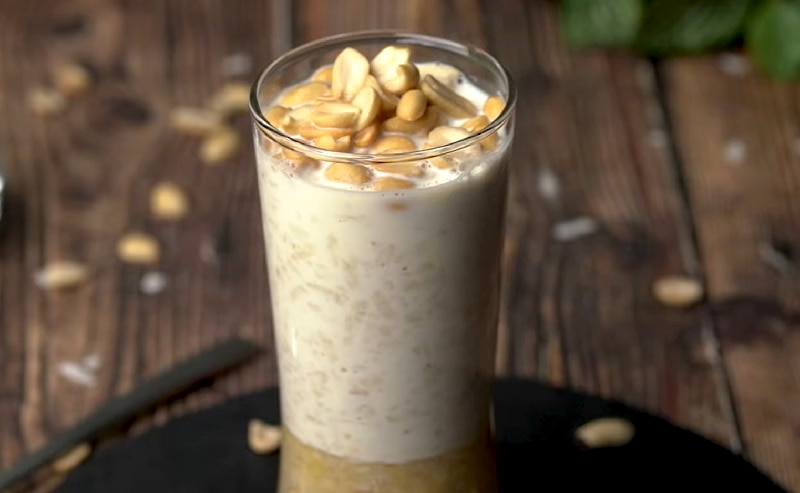
Aval Milk, also known as Avil Milk, is a popular beverage originating from the Malabar region of Kerala, India, often found in street stalls. This Kerala cuisine drink is crafted using aval, which is essentially flattened rice flakes or poha, combined with ripe bananas, milk of any variety, and an assortment of nuts. The preparation involves soaking the aval in milk until it softens, blending it with ripe bananas to lend natural sweetness, and garnishing with various nuts for added texture and flavor. The result is a creamy and nutritious drink enjoyed by locals and visitors alike, offering a refreshing respite from the tropical heat of Kerala. Aval Milk not only serves as a delightful refreshment but also showcases the culinary richness and diversity of Kerala's street food culture.
Thepla
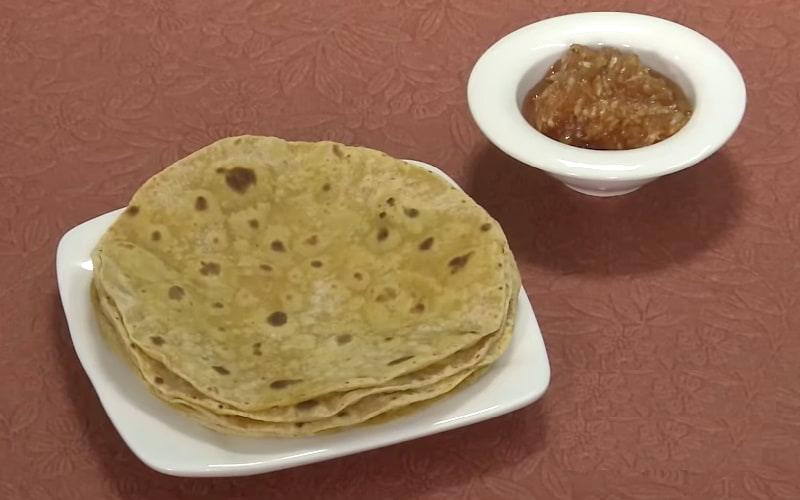
Thepla is a popular Indian flatbread that originates from the state of Gujarat. It is a versatile and flavorful dish made with whole wheat flour, gram flour (besan), and a blend of spices. The dough is prepared by mixing these ingredients along with yogurt, oil, and various spices like turmeric, red chili powder, and cumin. The dough is then rolled into thin, round discs and cooked on a griddle or tawa with a drizzle of oil until both sides are golden brown. The addition of finely chopped fenugreek leaves (methi) or other greens enhances the flavor and nutritional value. Thepla is a staple in Gujarati households and is often enjoyed with yogurt, pickles, or a dollop of ghee. It is a popular travel snack due to its long shelf life and the ability to stay soft even when cold. Thepla is not only delicious but also a convenient and wholesome option for breakfast, lunch, or dinner.
Umbadiyu
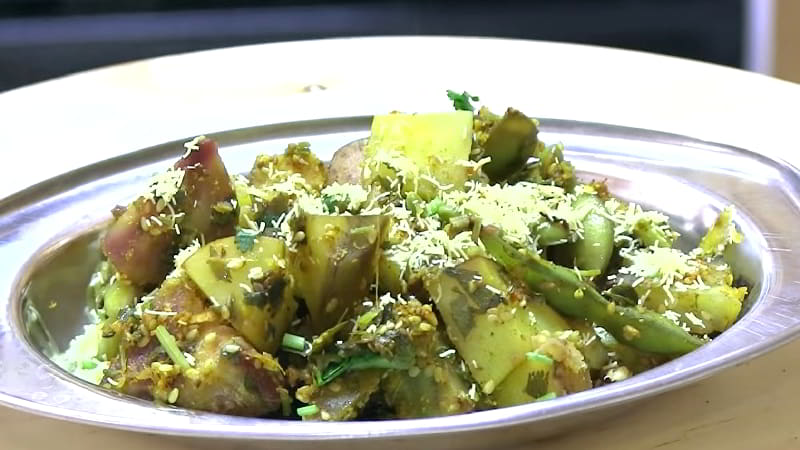
Umbadiyu, also known as Ubadyu, is a beloved seasonal delicacy originating from the districts of South Gujarat, particularly Valsad. This local dish features a delightful array of ingredients, including purple yam, potatoes, green beans, and sweet potatoes. What sets Umbadiyu apart is its distinctive aroma and earthy flavor, derived from the inclusion of Kamboi (Black honey shrub) and kalar (Indian nettle). Prepared traditionally in a rounded earthen pot placed upside down over a fire, Umbadiyu earns its nickname as the 'Gujarati Barbeque' owing to its smoky essence. The cooking process infuses the dish with a unique depth of flavor, making it a cherished culinary tradition in the region. Umbadiyu's combination of seasonal produce and aromatic spices captures the essence of Gujarat's vibrant food culture, offering a tantalizing taste of local flavors and traditions.
Farsan
-1713933123.jpg)
Farsan encompasses a diverse array of savory snacks, often served as appetizers or accompaniments to main meals. These dishes are celebrated for their distinctive flavors, textures, and spice blends. One well-loved farsan delicacy is Dhokla, a steamed cake crafted from fermented rice and chickpea flour, renowned for its airy texture and subtly tangy, sweet taste. Another favorite is Khandvi, created from a batter of gram flour and yogurt, rolled into delicate strips and adorned with mustard seeds, grated coconut, and fresh coriander. Farsan delights not only tantalize the taste buds but also reflect India's rich culinary heritage. Ideal for tea time, gatherings, or a quick snack fix, these savory treats add a flavorful dimension to any occasion.
Sosyo
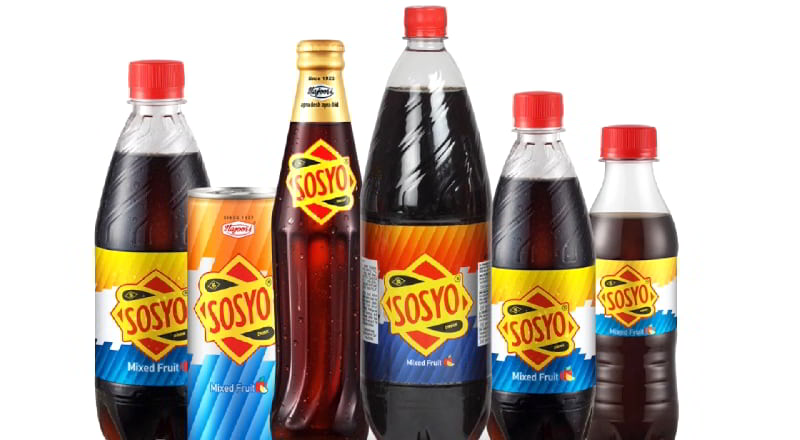
Sosyo, an Indian carbonated beverage, is primarily manufactured and distributed in the western and northern regions of India, including Gujarat, Maharashtra, Rajasthan, Uttar Pradesh, and Madhya Pradesh, with its base in Surat. This fizzy drink has historical roots in the Swadeshi movement during the Indian independence struggle. Launched in 1927 by Mohsin Hajoori in Surat, Sosyo emerged as a homegrown alternative to the British drink Vimto, which had been introduced in India by the same entrepreneur in 1923. In a notable development, Reliance Consumer Products, a subsidiary of Reliance Retail, secured a 50% stake in Sosyo Hajoori Beverages in January 2023. This strategic acquisition reflects the ongoing evolution of Sosyo within the Indian market.
Khakhra
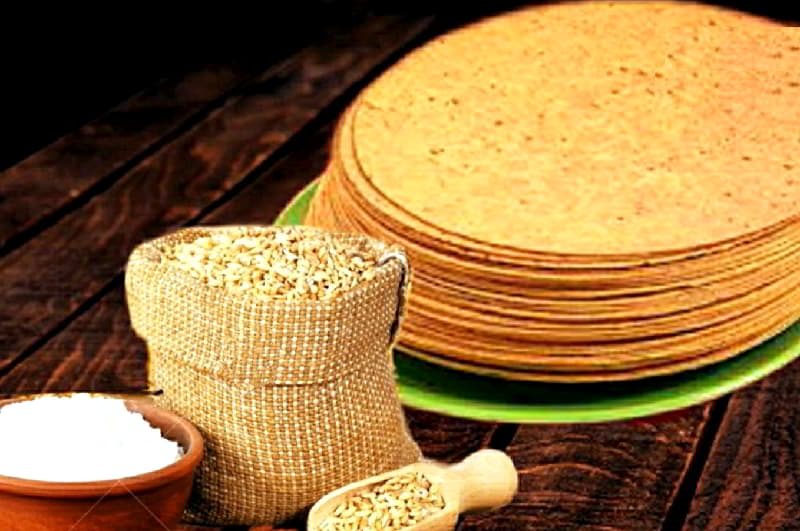
Khakhra, a staple in the Gujarati cuisine of western India, is a thin, crispy cracker enjoyed for its lightness and versatility. Crafted from a blend of mat bean, wheat flour, and oil, Khakhra is meticulously prepared to achieve its signature texture and flavor. Often savored during breakfast, it serves as a delightful accompaniment to various dishes or as a standalone snack. The simplicity of its ingredients belies its satisfying crunch and subtle taste, making it a favorite among locals and visitors alike. Whether paired with a cup of chai or enjoyed with chutney or pickle, Khakhra embodies the essence of Gujarati culinary traditions, offering a delicious and convenient option for any time of day.
Ghugni
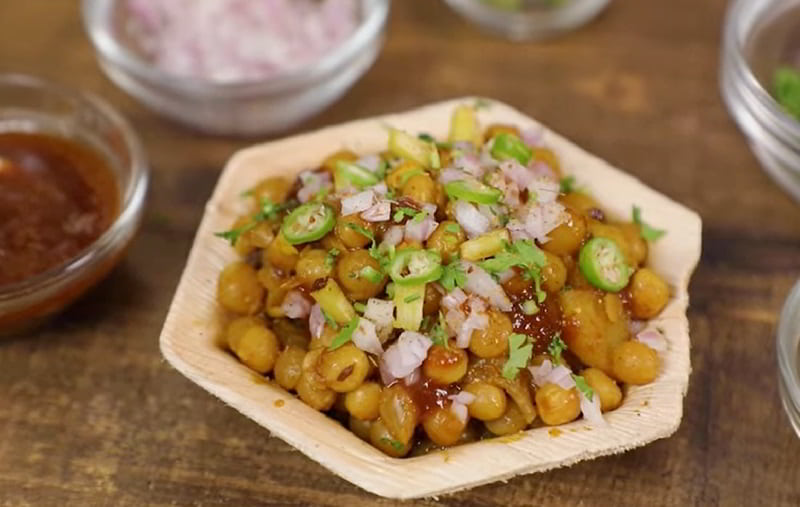
Ghugni is a delicious and nutritious dish made from dried white/yellow peas or black chickpeas cooked in a variety of aromatic spices. To prepare Ghugni, the peas or chickpeas are soaked overnight and then cooked until soft. In a separate pan, a tempering of mustard oil, cumin seeds, and bay leaves is prepared. Chopped garlic, onions, and ginger are sautéed until golden brown. Then, a blend of ground spices like coriander, red chili powder, turmeric, and cumin, is added to the pan, creating a flavorful base. The cooked peas or chickpeas are then added to the pan along with some water, allowing the dish to simmer and the flavors to meld together. Ghugni is typically garnished with chopped coriander leaves and served with a squeeze of lemon juice on top.
Suji Ka Halwa
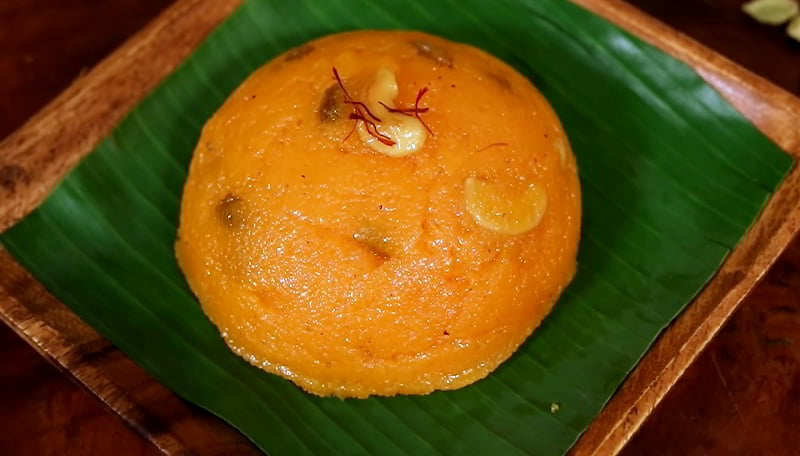
Suji ka halwa stands as a beloved delicacy in India, prepared with semolina (suji), ghee (clarified butter), sugar, and an array of nuts and spices. This sweet, aromatic dessert finds its place at the heart of festivals and special occasions. To craft suji ka halwa, semolina undergoes a golden roasting in ghee, acquiring a delightful nuttiness. Sugar and water are then introduced, simmering into a velvety consistency. Elevating the dish, cardamom powder, saffron strands, and a lavish assortment of chopped nuts like almonds, cashews, and pistachios are incorporated. Served warm, often adorned with additional nuts, suji ka halwa boasts a sumptuous taste where the sweetness harmonizes seamlessly with the aromatic spices, creating a rich and indulgent experience.
Baati
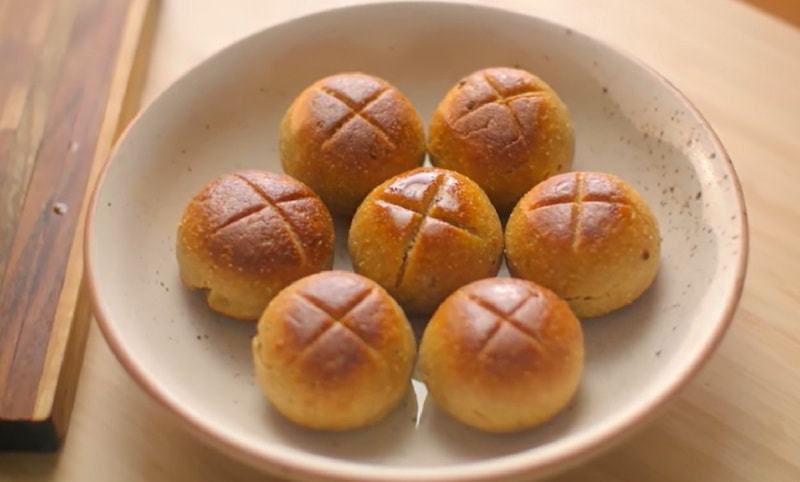
Baati, a firm and unleavened bread, is a culinary staple in many regions of Rajasthan, and extends its presence to parts of Madhya Pradesh and Gujarat in India. Celebrated for its extended shelf life and rich nutritional profile, especially valued in arid landscapes due to its minimal water requirements for preparation. Often paired with dal, it is aptly known as dal baati. In certain areas, like Madhya Pradesh, it finds companionship with a roasted aubergine mash known as bharta. Baati shares similarities with Litti, a cuisine popular in eastern Uttar Pradesh (Varanasi), and western Bihar, which is enjoyed with roasted aubergine, potato, and tomato. Baati can be either plain or feature diverse fillings, ranging from onions and peas to sattu.
Thoran
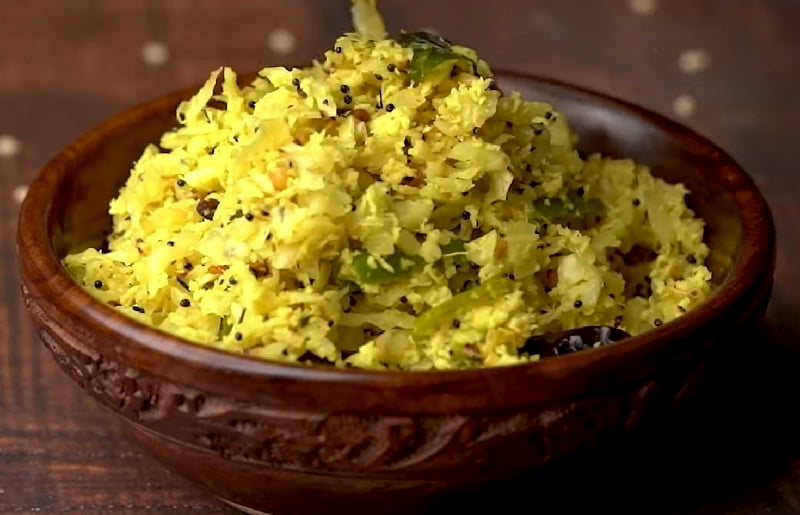
Thoran, also known as upperi in Northern Kerala, represents a category of dry vegetable dishes enriched with coconut, originating in the Indian state of Kerala. A ubiquitous dish, it is commonly enjoyed alongside rice and curry, forming an integral part of the traditional Keralite sadhya. Thoran comprises finely chopped vegetables like yardlong beans, bittergourd (or elephant foot yam), cabbage, various bean varieties, and unripe jackfruit. Additionally, it may feature leaves such as green or red spinach, Moringa oleifera, or Ipomoea aquatica, as well as flowers like Moringa oleifera or Sesbania grandiflora. The preparation involves mixing the chopped vegetables with mustard seeds, turmeric powder grated coconut, and curry leaves, followed by a brief sauté on a high-heat pan. This culinary delight offers a flavorful and textured complement to the traditional South Indian meal.
Khaman
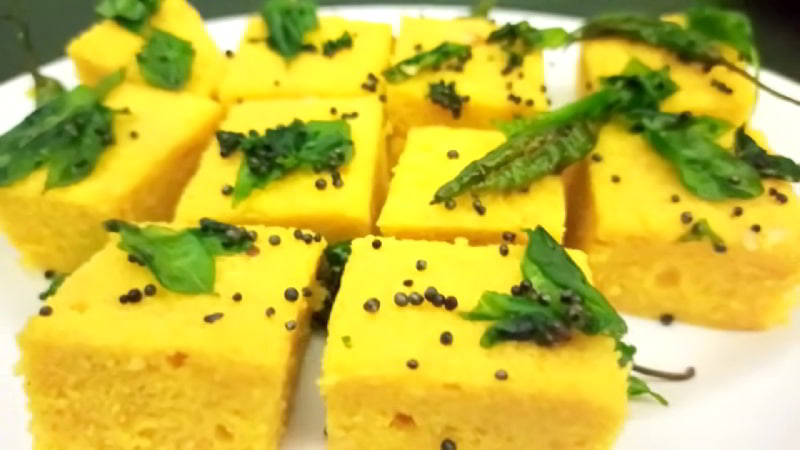
Khaman, a renowned savory snack originating from Gujarat, India, has garnered widespread popularity. Crafted from ground channa dal or channa gram flour, the preparation typically includes ingredients like semolina, lemon juice, and curd. To impart a finishing touch, a tadka can be applied, featuring elements such as asafoetida and chilies. This delectable treat boasts a unique blend of flavors and textures, capturing the essence of Gujarati culinary excellence. Khaman's appeal lies in its harmonious combination of channa dal, the richness of curd, citrusy notes from lemon juice, and the subtle graininess from semolina. The optional tadka elevates the snack, introducing a layer of aromatic complexity with asafoetida and a hint of spiciness from chilies.
Mohanthal
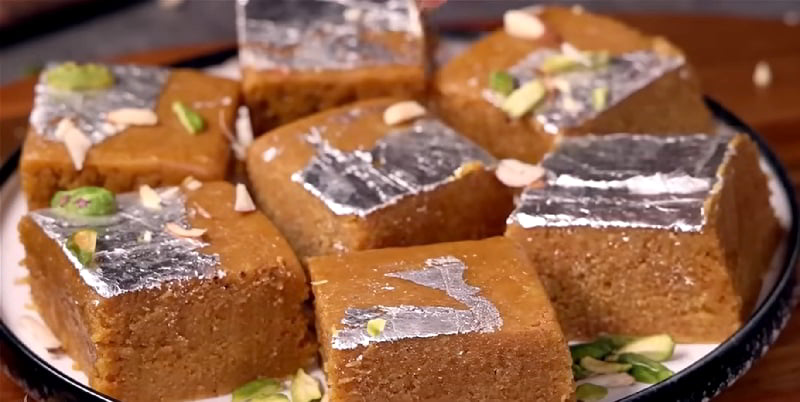
Mohanthal, a traditional Indian sweet rooted in besan (gram flour), holds special significance as a favorite of Hindu God Bhagwan Krishna. This delectable treat is prominently prepared during the Sri Krishna Janamashtami festival, honoring Bhagwan Krishna, often referred to as Mohan. Mohanthal holds a central place in the bhog offered in Pushtimarg temples. Crafted from besan, ghee, and sugar, Mohanthal lends itself to various additions, including spices and nuts. Like many other sweets in the Indian subcontinent, it is commonly savored during religious festivities such as Diwali and Krishna Janamashtami or as prasad, a sacred offering in temples. Its name itself pays homage to the divine connection with Bhagwan Krishna.
Chiroti
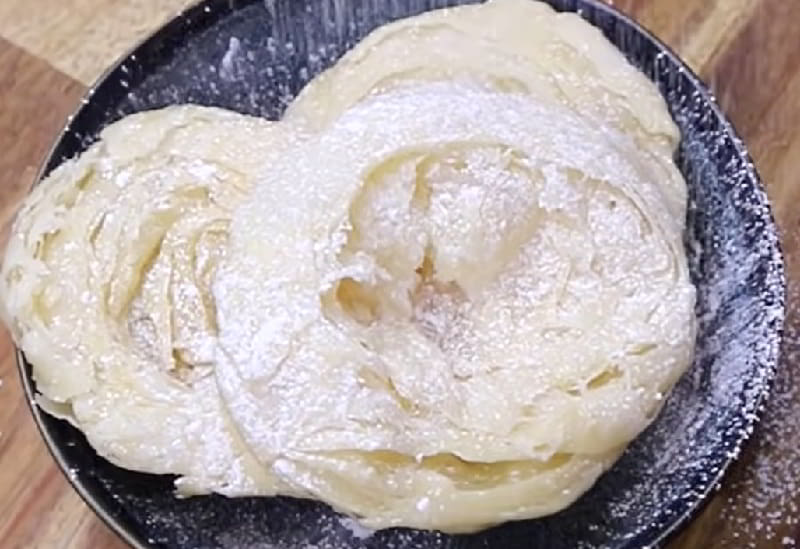
Chirote, also known as Chiroti, is a cherished delicacy originating from Maharashtra and the former Bombay State regions of Karnataka. Additionally, it enjoys popularity in parts of Telangana, particularly in Nalgonda district, where it is referred to as Pheni or Peni. This exquisite treat is typically reserved for special occasions like festivals or weddings, where it is served as a dessert. To prepare Chirote, a dough of refined flour (maida) is kneaded and rolled out into thin, layered circular shapes. These delicate discs are then deep-fried in ghee or refined oil until they achieve a semi-golden brown hue, resulting in a fluffy texture akin to poori. Once fried, Chirote are generously dusted with powdered sugar and optionally adorned with grated almonds and cashews. This indulgent treat captivates palates with its crispy yet melt-in-your-mouth texture, making it a beloved addition to celebratory feasts across regions.
Fafda
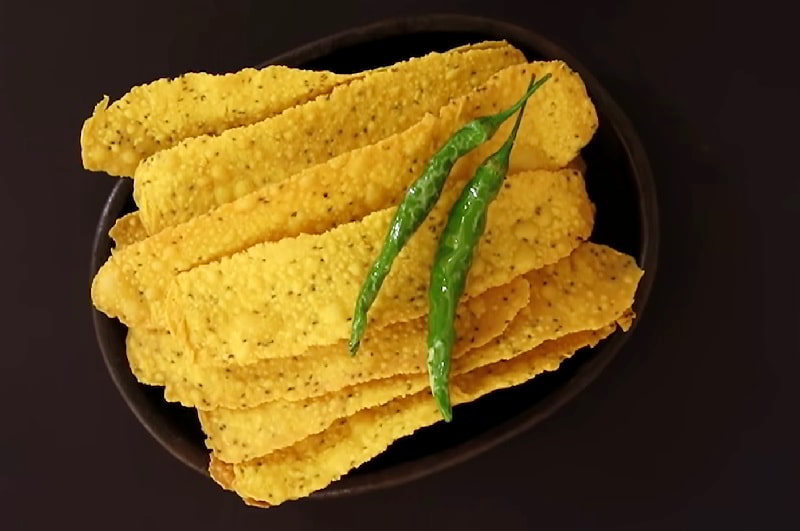
Fafda is a crispy and savory snack, commonly relished for breakfast or as an evening accompaniment with tea. The preparation involves combining besan (gram flour), turmeric, ajwain (carom seeds), and various spices. The resulting dough is rolled into thin, lengthy strips and deep-fried until achieving a delightful golden brown crispiness. Fafda is typically paired with green chutney and jalebi, a sweet and sticky dessert. The juxtaposition of the crunchy fafda, tangy chutney, and sweet jalebi yields a harmonious blend of flavors. Beyond its deliciousness, fafda holds cultural significance in Gujarat, being a favored choice during festivals and special occasions, as well as a popular street food delight.
Ghari
-1711725405.jpg)
Ghari, or Surati Ghari, is a sweet delicacy hailing from Surat, Gujarat, India. Crafted from sugar, puri batter, milk 'mawa,' and ghee, it takes the form of round-shaped treats with sweet fillings, traditionally enjoyed during the Chandani Padva festival. This delectable dish comes in various enticing varieties and flavors, including almond-elachi, pistachio, and mawa, offering a diverse and delightful range for discerning palates. Ghari showcases the culinary artistry of Gujarat, presenting a harmonious fusion of ingredients that contribute to its unique taste and texture. Whether savoring the classic version or exploring the nuanced variations, Ghari remains a symbol of the rich culinary heritage of Surat, adding sweetness to festive celebrations and capturing the essence of Gujarat's sweet traditions.
Gujarati Thali
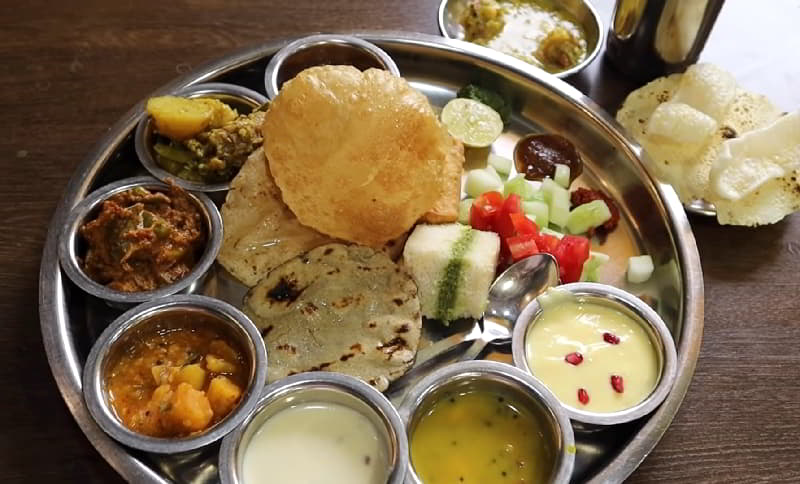
The Gujarati Thali is a wholesome and balanced meal that consists of a variety of different dishes served on a large platter. The thali typically includes a combination of sweet, salty, spicy, and tangy flavors, showcasing the diverse flavors of Gujarati cuisine. The main components of a Gujarati Thali include roti (Indian bread), rice, dal (lentil soup), kadhi (yogurt-based curry), a variety of vegetable curries, pickles, chutneys, papad (crispy lentil wafers), and buttermilk. Some popular dishes that are commonly found in a Gujarati Thali are Undhiyu (a mixed vegetable curry), Khandvi (a rolled gram flour snack), Dhokla (a steamed fermented rice and lentil cake), and Shrikhand (a sweet yogurt dessert). The Gujarati Thali is not only a feast for the taste buds but also for the eyes. The different dishes are beautifully arranged on the platter, creating an appetizing and visually appealing meal. It is a culinary experience that showcases the rich flavors and culinary traditions of Gujarat.
Misal
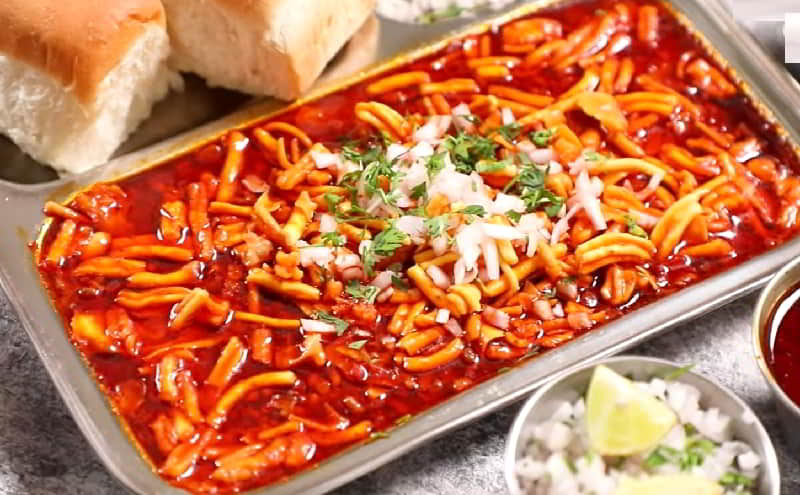
Misal is a spicy and flavorful dish that is often enjoyed for breakfast or as a snack. The main ingredient of Misal is sprouted moth beans, which are cooked with a variety of spices and served with a medley of toppings. To prepare Misal, the sprouted moth beans are cooked with onions, tomatoes, ginger, garlic, and a blend of aromatic spices such as turmeric, cumin, coriander, and red chili powder. This mixture is then simmered until the flavors meld together and the beans are tender. Once the Misal is ready, it is typically served in a bowl topped with farsan (a crispy snack made from gram flour), chopped onions, fresh cilantro, and a squeeze of lemon juice. Some variations of Misal also include a side of pav (a type of bread) to soak up the delicious gravy. Misal is known for its spicy and tangy flavors, making it a favorite among spice lovers. It is a hearty and filling dish that is enjoyed by people of all ages.
Dal Dhokli
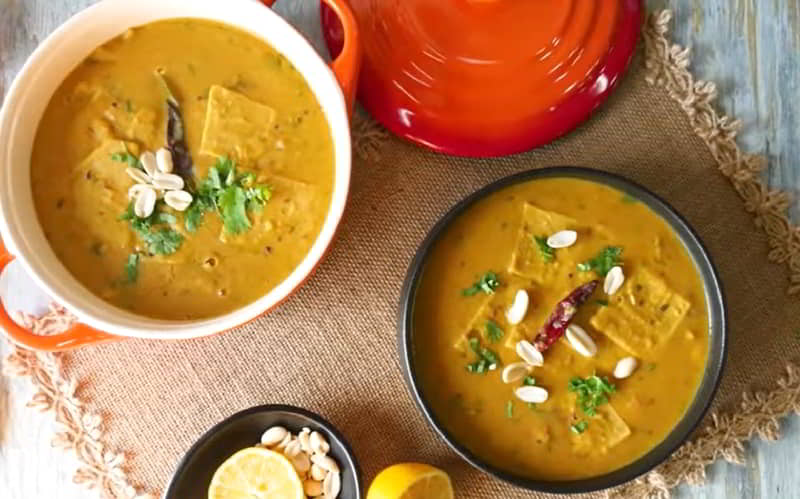
Dal dhokli is a comforting one-pot meal that combines the goodness of lentils and wheat flour dumplings. To make dal dhokli, first, a flavorful lentil soup is prepared using pigeon peas (toor dal) and a blend of spices like turmeric, cumin, and coriander. The lentils are cooked until soft and then tempered with mustard seeds, curry leaves, and asafoetida, which adds a unique aroma. Next, small pieces of wheat flour dough are rolled out into thin circles and added to the simmering lentil soup. These dumplings, known as dhokli, cook in the dal and absorb the flavors of the soup, becoming soft and delicious. The final dish is a hearty and wholesome combination of lentils, dumplings, and spices. It is often garnished with fresh coriander leaves and served with a dollop of ghee (clarified butter) on top. The balance of flavors, textures, and aromas in dal dhokli make it a popular and comforting vegetarian choice in Indian cuisine.
Locho
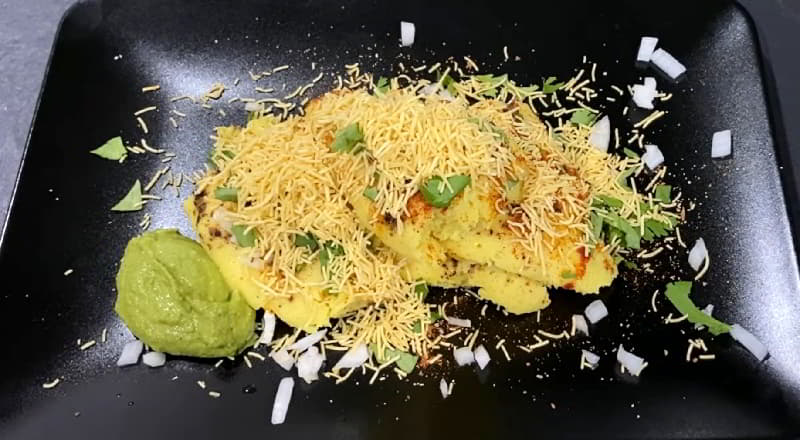
Locho, a steamed Gujarati Farsan (Snack/Side Dish), originated in Surat and is crafted from gram flour. This culinary delight is aptly named for its loose consistency and irregular, dumpling-like shape. While sharing some similarities with Khaman, it distinguishes itself by not being served in regularly cut pieces. The dish is commonly adorned with a medley of flavorful toppings, including oil, coriander, butter, spices, sev, and onion. Surti Locho, as it is locally known, has gained widespread popularity in Surat, becoming a culinary staple. Its appeal extends to other regions in South Gujarat, including Navsari. This unique and savory snack showcases the creativity and regional flavors of Gujarati cuisine, offering a delightful gastronomic experience with its steamed gram flour base and a diverse array of complementary toppings.
Muthia
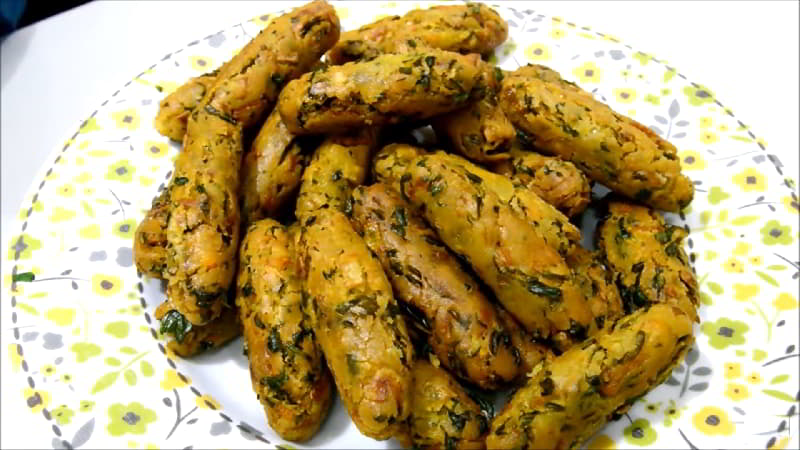
Muthia derives its name from the distinctive "gripping" action used in its preparation. This delicacy is crafted with salt, turmeric, chickpea flour, chili powder, methi (fenugreek), and can include optional ingredients like sugar and oil for added bonding and sweetness. The dish offers versatility, as it can be enjoyed either steamed or fried after steaming. In Gujarat, it goes by various names such as Muthiya, Velaniya, and Vaataa. Specifically termed 'vaataa' in the Charotar region of Central Gujarat, this dish sees additional variations incorporating coarse wheat flour and leafy greens like luni (purslane), amaranth, spinach, or grated bottle gourd. Following the steaming, these Muthias are tempered with sesame seeds and mustard seeds, presenting a flavorful and textured culinary experience.
Handvo
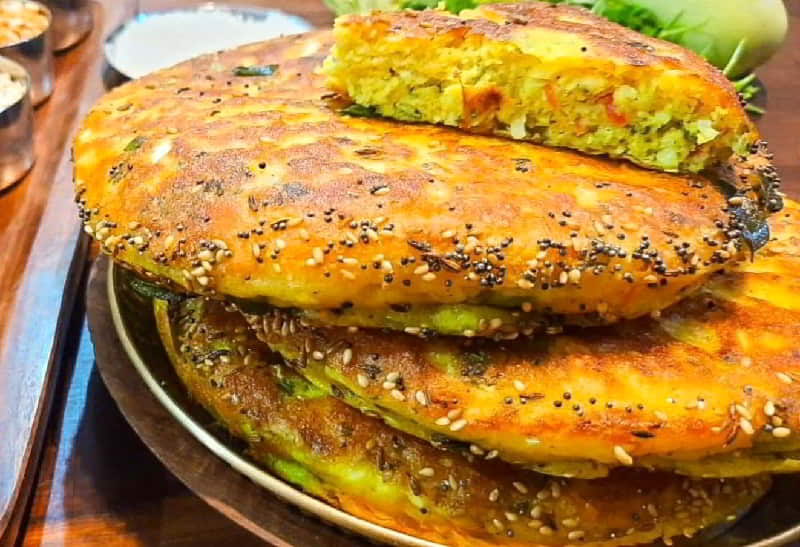
Handvo, a savory vegetable cake hailing from Gujarat, India, stands as a delectable part of Gujarati cuisine. While commonly featuring a bottle gourd filling, it offers versatility with the incorporation of various vegetables, and occasionally, crushed peanuts. The preparation involves a batter made from a blend of rice and assorted lentils, which are meticulously rinsed, dried, and ground. To create a fermented batter, this mixture is combined with yogurt. The final step includes adding more yogurt and spices to the batter, which is then steamed to perfection. This unique and flavorful dish exemplifies the culinary diversity of Gujarat, showcasing the harmonious combination of lentils, rice, and vegetables in a delightful, steamed cake form.
Khiramohana
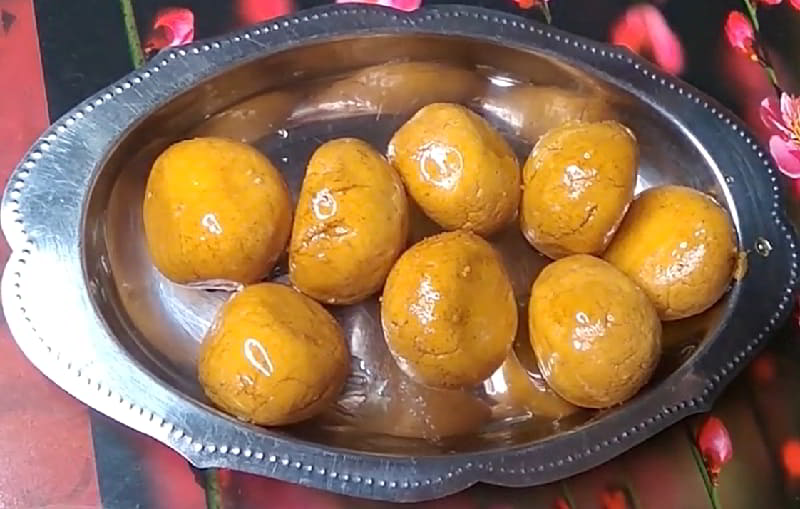
Khira Mohan, a creamy dessert widely enjoyed in Odisha, is crafted from chhena and a sugar syrup. This delectable treat is thought to be the precursor of Odia Rasgulla, with historical accounts suggesting that Khira Mohan originated in Odisha as an offering to the goddess Lakshmi at the Jagannath Temple in Puri. Khira Mohana, also known as Brown Rasogolla, has made its mark as a beloved dessert. The delicacy is not limited to Odisha but has gained popularity in Chauparan, Jharkhand, where numerous shops offer the sweet confection known as Khirmohan. This dessert, with its rich chhena base and sweet syrup, reflects the cultural and culinary traditions of the region, making it a cherished treat enjoyed by locals and beyond.
Sukhdi
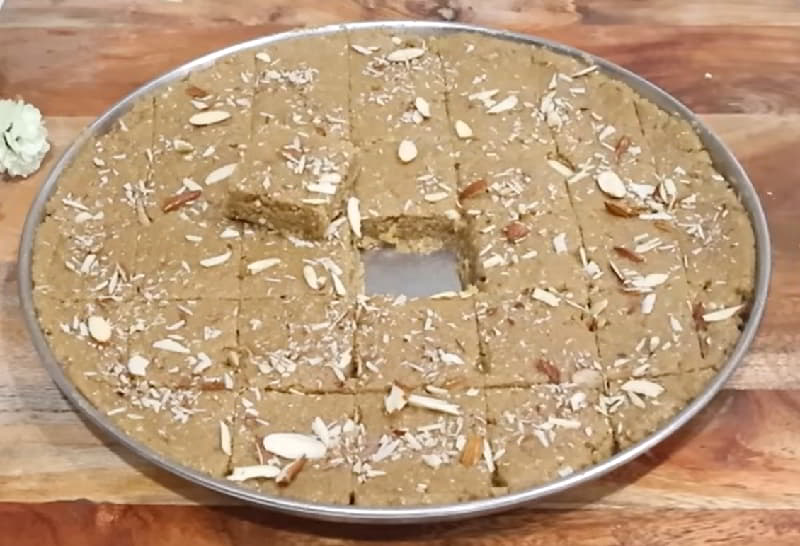
Sukhdi, also known as gur papdi, is a sweet and delicious treat made primarily from wheat flour, ghee (clarified butter), and jaggery (a type of unrefined sugar). To prepare Sukhdi, wheat flour is roasted in ghee until it turns golden brown, giving it a nutty flavor. Then, jaggery is added and melted into the mixture, providing a natural sweetness. The mixture is then poured into a greased tray and pressed down firmly. Once it cools and hardens, it is cut into square or diamond-shaped pieces. Sukhdi is not only a delectable dessert but also a nutritious snack. Wheat flour is a good source of carbohydrates and fiber, while jaggery offers essential minerals like iron and calcium. The ghee used in making Sukhdi provides a rich and creamy taste. This traditional Gujarati sweet is often enjoyed during festivals and special occasions.
Koottu
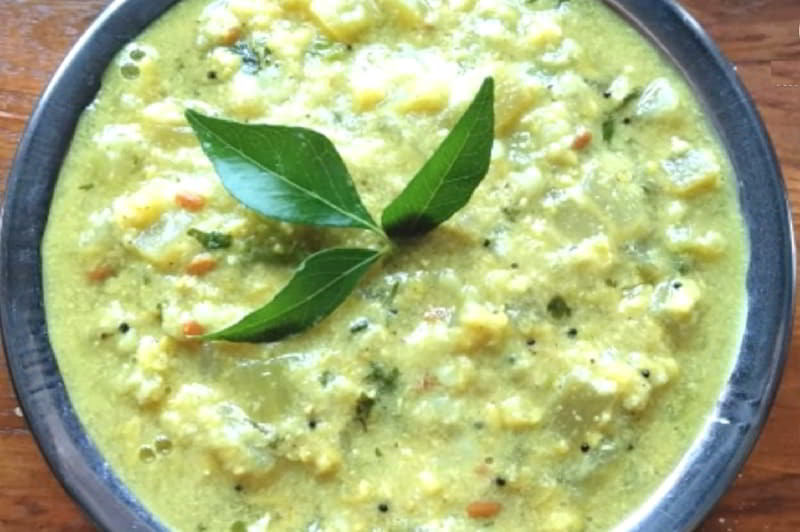
Koottu is a stew made with a combination of lentils, vegetables, and spices. To make koottu, various types of lentils like toor dal, moong dal, or chana dal are cooked until soft and then mixed with a variety of vegetables such as pumpkin, drumstick, beans, or carrots. The lentils and vegetables are cooked together with aromatic spices like turmeric, cumin, mustard seeds, and curry leaves. Koottu is known for its smooth and creamy texture, achieved by grinding coconut and adding it to the dish. The coconut adds a rich and slightly sweet flavor to the koottu. Additionally, tamarind pulp or lemon juice is added to give a tangy taste to balance the flavors. This hearty and wholesome dish is typically served with steamed rice or roti. It is not only delicious but also provides a good balance of protein, fiber, and essential nutrients.
Cucumber Raita
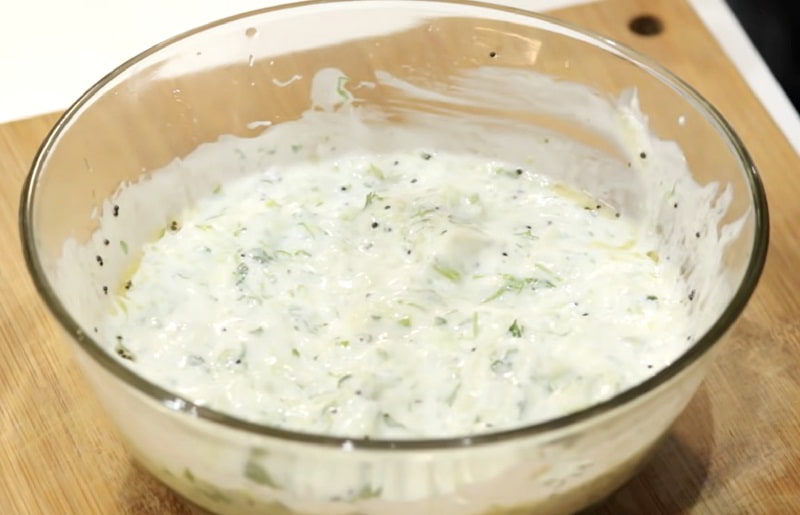
Cucumber Raita, a delightful variation of the traditional raita, serves as both a dip and a salad. Crafted by combining freshly chopped cucumber, green chillies, and dahi (yogurt), with the optional additions of finely chopped tomato and onion, this refreshing dish adds a burst of flavors to the palate. Particularly favored during the summer months, Cucumber Raita is renowned for its ability to provide a cooling effect, making it a popular choice to beat the heat. This versatile dish is commonly served as a side accompaniment to the main course in Indian cuisine, offering a crisp and invigorating contrast to the richness of other dishes on the dining table.
Jeera Aloo
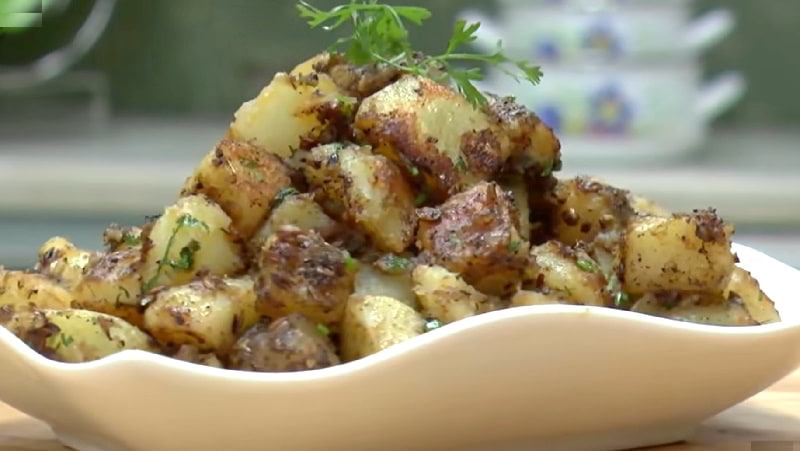
Jeera aloo is a flavorsome delicacy that showcases the wonderful flavors of cumin (jeera) and potatoes (aloo). To prepare jeera aloo, potatoes are boiled and then cubed or sliced. In a pan, cumin seeds are tempered in ghee or oil, releasing their aromatic flavors. The potatoes are then added to the pan and sautéed until they are golden and crispy on the outside. Additional spices like turmeric, red chili powder, and coriander powder are added to enhance the taste. Salt is added to season the dish, and sometimes lemon juice is squeezed over the potatoes for a tangy twist. Jeera aloo can be enjoyed as a main course or as a side dish with roti (Indian bread) or rice. It is a versatile dish that can be customized to suit individual preferences by adding other vegetables like peas or bell peppers. The combination of the earthy cumin flavor with the creamy texture of the potatoes makes jeera aloo a delightful and satisfying vegetarian option in Indian cuisine.
Thecha
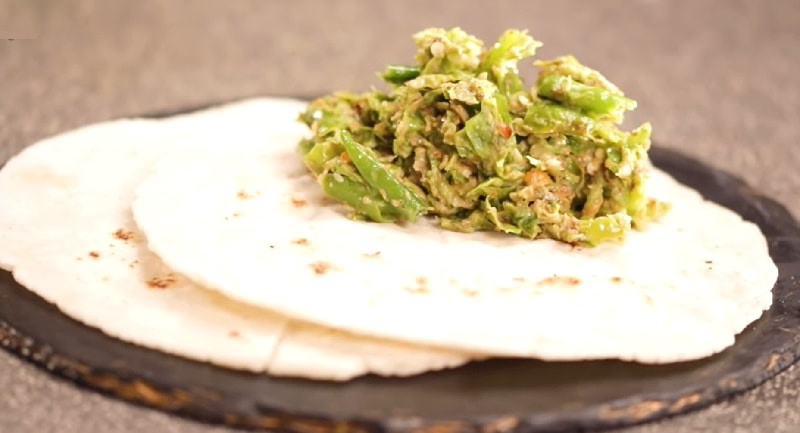
Thecha, a zesty condiment hailing from Maharashtra, India, is known for its fiery flavor profile. While variations exist, the core ingredients include chili peppers (green or red), peanuts, and garlic, often tempered in peanut oil. A blend of spices such as coriander seeds, cumin, cloves, sesame seeds, coriander leaves, hing, and grated coconut adds depth to its taste. Traditional preparation involves crushing or pounding these ingredients using a metal or mortar and pestle, but modern kitchens often employ food processors. Thecha is commonly paired with dishes like pithla bhakri or enjoyed with bhakri. A regional twist on this condiment is the varhadi thecha, showcasing the diverse and flavorful culinary traditions of Maharashtra.
Khichu
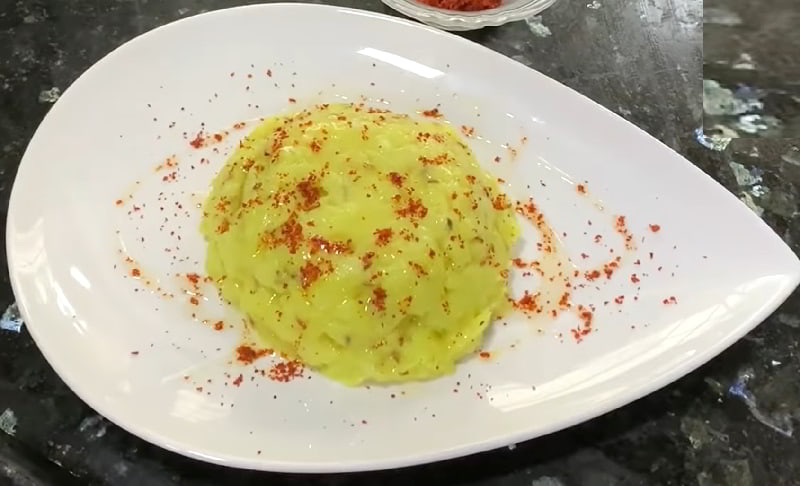
Khichu, initially a dough for crafting papad, has evolved into a delectable snack or side dish due to its appealing taste. Created from rice flour, though occasionally employing other flours, this treat is made by cooking the flour in water, akin to a porridge, with the infusion of cumin seeds and an alkaline salt called Papad Khar. The resultant lump is then steamed to perfection. Khichu is commonly enjoyed with a drizzle of oil and a sprinkle of chili powder. The name "khichiyu" or "khichu" is derived from the dough's malleable and ductile nature, highlighting its pliable and versatile culinary characteristics. Whether relished as a snack or an accompaniment, Khichu showcases the adaptability and flavors intrinsic to its preparation.
Bhindi Fry
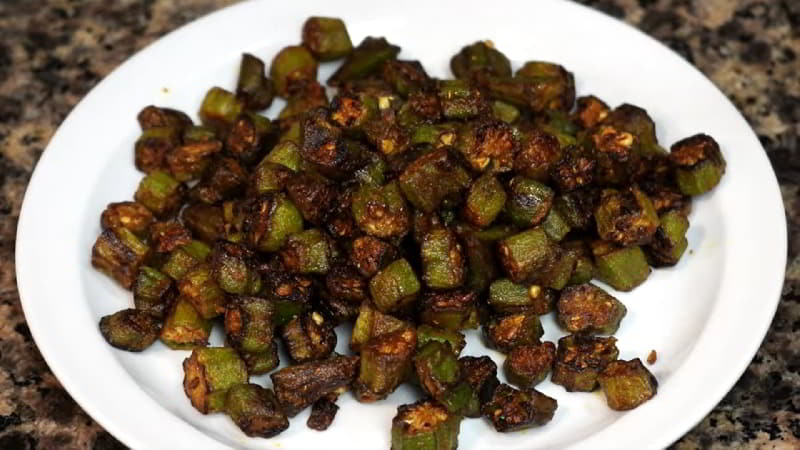
Bhindi fry highlights the delectable flavors of okra and is renowned for its simplicity and compatibility with various Indian meals. To prepare this dish, fresh okra is meticulously washed and dried to eliminate moisture. The okra is then cut into bite-sized pieces and sautéed in a pan with a blend of aromatic spices. Common additions include cumin, turmeric, chili powder, and coriander, contributing not only a rich and aromatic taste but also a vibrant color to the dish. The okra is fried until achieving a crispy and slightly caramelized texture, providing a delightful crunch that contrasts with its tender interior. Garnished with fresh cilantro leaves, bhindi fry is served hot and proves to be a versatile dish, enjoyed as a side or main course with roti or rice.
Kansar
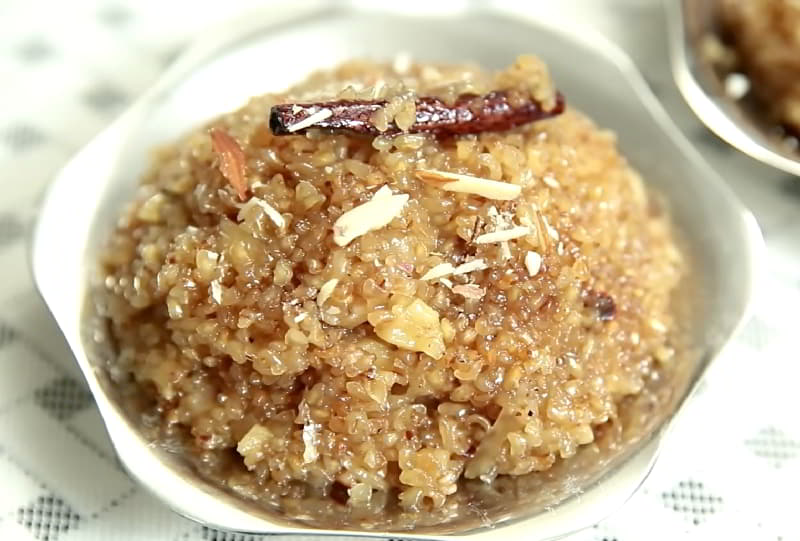
Kansar is a sweet dessert originating from Gujarat, India, featuring clarified butter, sugar powder, and whole wheat flour (or broken wheat), and as its primary ingredients. In Gujarati culture, presenting Kansar to guests is a gesture of respect, and the dish holds significance in traditional wedding ceremonies and various joyous occasions. The sweet and symbolic nature of Kansar makes it a cherished treat associated with celebrations and gatherings in Gujarat. Its preparation involves a harmonious blend of wholesome ingredients, reflecting the cultural richness and warmth inherent in Gujarati hospitality. The sweet allure of Kansar not only satisfies the taste buds but also carries with it a tradition of sharing joy and expressing hospitality in the vibrant tapestry of Gujarati culture.
Sev Mamra
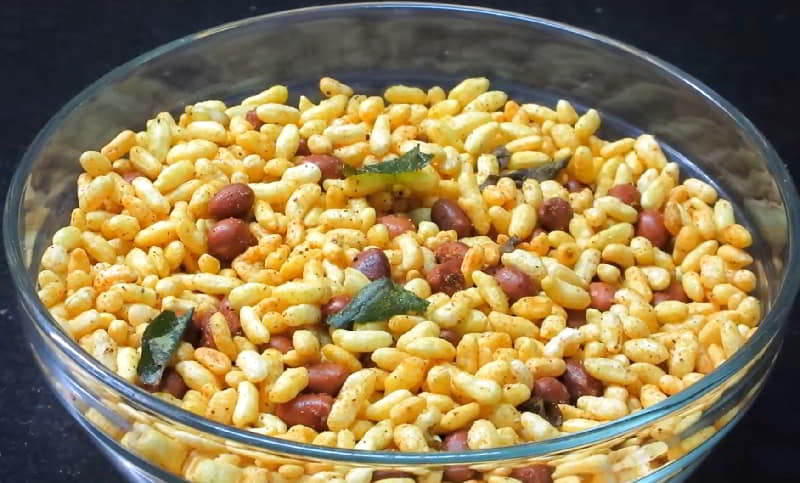
Sev mamra, also known as mixture, stands as a popular Indian snack comprised of an enticing mix of spicy ingredients like puffed rice (mamra), savory fried noodles (sev), and peanuts. Sauteed in oil with turmeric powder, chili powder, curry leaves, and salt, this snack boasts a flavorful blend. Regional variations introduce diverse elements such as capsicum, onions, or pickled mangos, lending a unique touch to the preparation. Widely available across India, this delectable treat goes by different names in various regions, including 'sev murmura' and 'sev kurmura.' Embodying a harmonious amalgamation of textures and spices, sev mamra is a beloved snack enjoyed nationwide, reflecting the diversity and creativity inherent in Indian culinary traditions.
Doodhpak
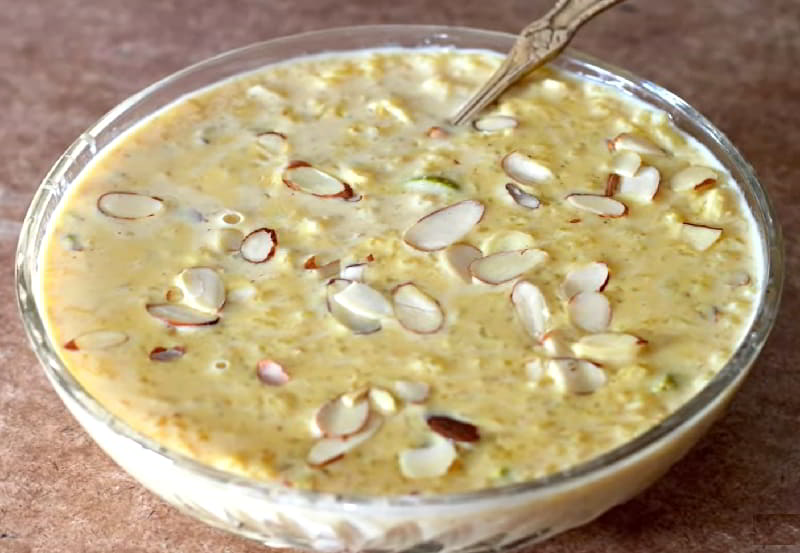
Doodhpak, a cherished traditional dessert, is adored for its creamy and opulent taste, making it a favorite during festive celebrations. This delightful dish is crafted with a blend of milk, rice, sugar, and a generous assortment of dry fruits and nuts. To prepare Doodhpak, rice is simmered in milk until it attains a soft and tender consistency. Aromatic ingredients such as cardamom, saffron, and rose water are then introduced, infusing a delightful fragrance. Sugar is added to sweeten the dish, and the mixture is simmered until it achieves a luscious, creamy thickness. Dry fruits like almonds, cashews, and pistachios enhance the texture, providing a delightful crunch. Some variations include raisins and grated coconut for added flavor. Doodhpak can be served warm or chilled, often garnished with a sprinkle of crushed nuts, presenting a comforting and indulgent dessert enjoyed by individuals of all ages. Its creamy texture and aromatic nuances make it a delightful treat for any occasion.
Kadhi Bari
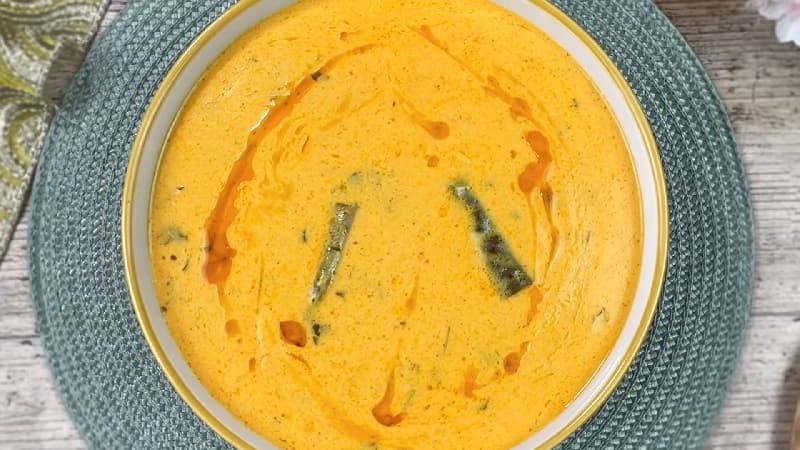
Kadhi bari, a popular South Asian curry, is a delicious blend of gram flour, dahi (yogurt), and spices. Enjoyed in Indian states like Bihar, Jharkhand, Uttarakhand, and Uttar Pradesh, as well as in Bagmati, Lumbini, Madhesh, and No.1 provinces of Nepal, this dish is a regional favorite. The bari, created from a besan paste formed into dumplings, is deep-fried in cooking oil. Simultaneously, the kadhi is prepared by gram flour, mixing dahi, and spices. Typically savored during summers and festivals like Holi, Jur Sheetal, and Krishna Janmashtami, it pairs exceptionally well with steamed rice but can also be served with roti and puri. Kadhi bari exemplifies the regional diversity and culinary richness prevalent in South Asian cuisine.
Chhundo
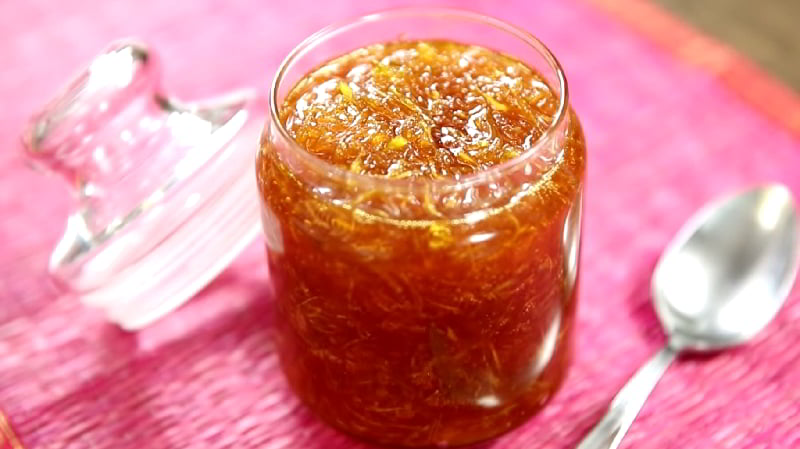
Chhundo is an Indian pickle and condiment crafted mainly from grated green mangoes. It is a customary accompaniment to the main meal, complementing dishes like Roti and Sabzi in the Indian subcontinent. While traditionally a Kathiawadi specialty, Chhundo is enjoyed throughout Gujarat and beyond. Although originally mango-based, this preparation is versatile and can be made with various fruits and vegetables. As mangoes are seasonal, predominantly available from April to July in India, Chhundo and other pickles are concocted during this period with either oil or sugar bases. Preserved in large glass containers, these pickles, including Chhundo, become readily available for consumption throughout the year, adding a burst of flavor to meals across different seasons.
Makka Poha
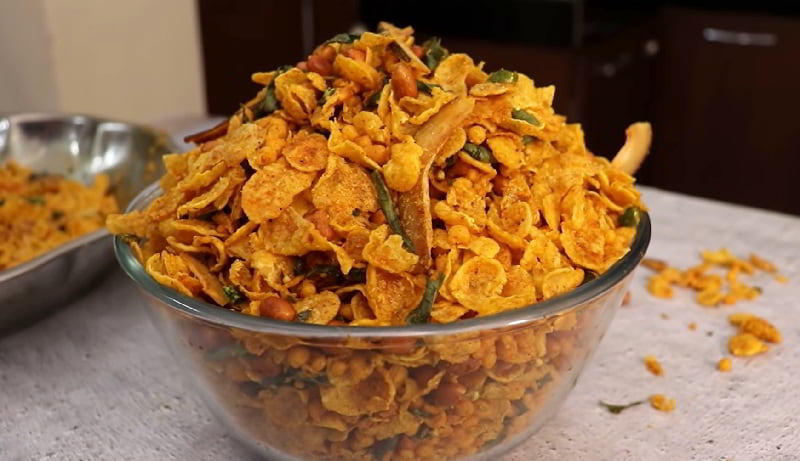
Makka poha, a delightful component of Indian Gujarati cuisine, is also known as corn or maize flakes. Unlike the ready-to-eat breakfast cereal cornflakes, makka poha requires frying in hot oil to puff up before being enjoyed as a snack. This crispy and savory treat plays a crucial role in the preparation of farsan, specifically in the creation of chevda, a popular savory snack in Gujarati cuisine. Makka poha adds a unique texture and flavor to the chevda, contributing to its overall deliciousness. With its distinct preparation method and versatile use in various savory dishes, makka poha stands out as a noteworthy element in the vibrant tapestry of Gujarati culinary traditions.
Dhebra
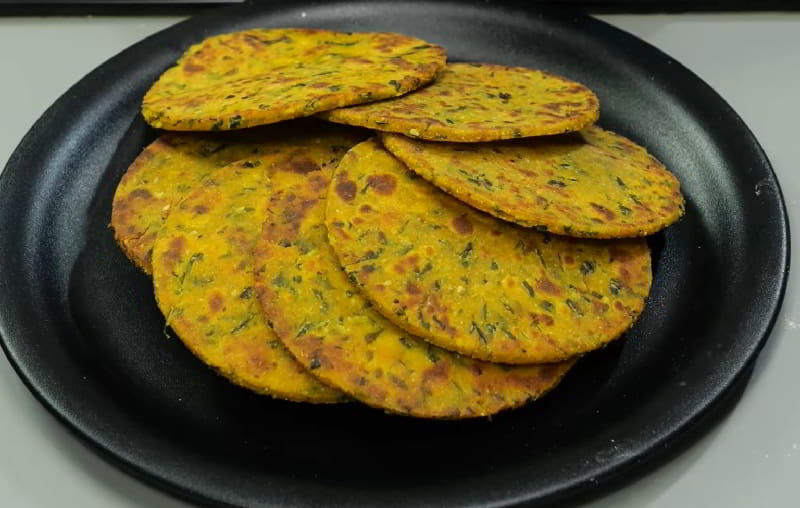
Dhebra is an Indian bread made from pearl millet flour. When combined with fenugreek leaves, it transforms into methi dhebra. To make dhebra, millet flour is blended with water and salt to create a dough which is then rolled into balls before being flattened into round shapes on a chakla using a belan (rolling pin). It is then steamed with vegetable oil both sides on a tava until small brown dots or spots appear. The plain dhebra, crafted exclusively from millet flour (bajra atta), represents the most straightforward version and is widely enjoyed in India. Conversely, the methi dhebra incorporates fenugreek leaves for an additional burst of flavor, providing a delightful variation in the diverse range of dhebra options.
Dahi Baigana
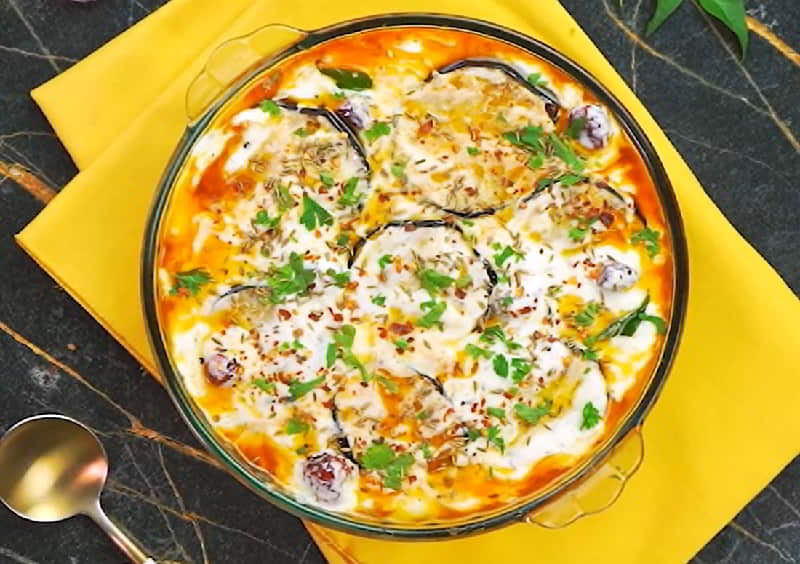
Dahi baigana, an Odia dish commonly enjoyed during festivals, features a delectable combination of yogurt and eggplant. This dish can be tailored to adhere to dietary restrictions during auspicious festivals by omitting onion and garlic. The ingredients include curry leaves (bhrusanga patra), eggplant, yogurt, vegetable oil or ghee, fennel seeds (pan mahuri), mustard seeds, fenugreek seeds (methi), cumin seeds (jeera), dry chili (sukhila lanka maricha), ginger, green chili, salt, and sugar. A variation of Dahi baigana in Kashmiri cuisine incorporates spice paste and a generous amount of chili powder, giving it a distinctive golden hue. Despite regional nuances, the dish remains a flavorful and festive delight, showcasing the diverse culinary traditions present in different parts of India.
Kadai Paneer
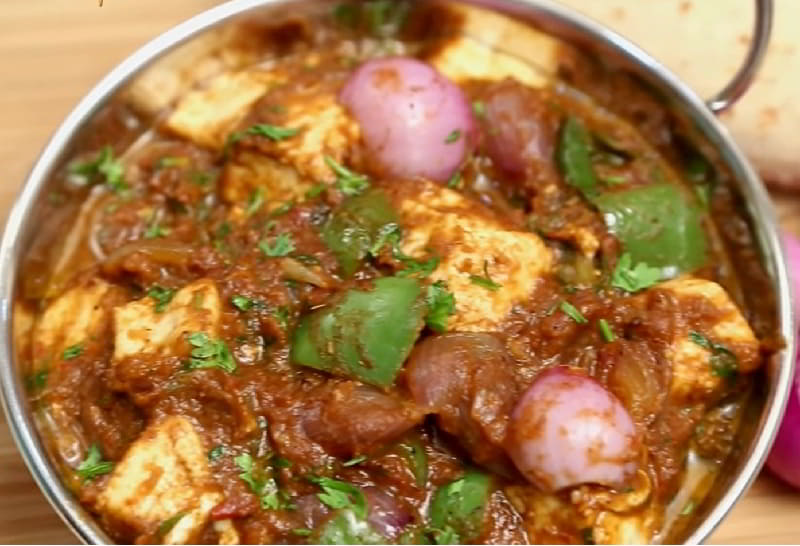
Kadai Paneer, also known as Kadhai Paneer, is an enticing Indian dish that involves cooking paneer and bell peppers in a flavorful, freshly ground spice powder. This aromatic creation is commonly served alongside buttered naan, paratha, roti, jeera rice, or steamed basmati rice. The dish showcases a harmonious blend of textures and flavors, with the paneer's creamy richness complementing the vibrant and slightly smoky taste of bell peppers. The fragrant spice powder, prepared specifically for Kadai Paneer, enhances the overall culinary experience. This versatile dish not only satisfies the taste buds but also offers a visually appealing presentation, making it a popular choice across various Indian culinary settings.
Gujarati Kadhi
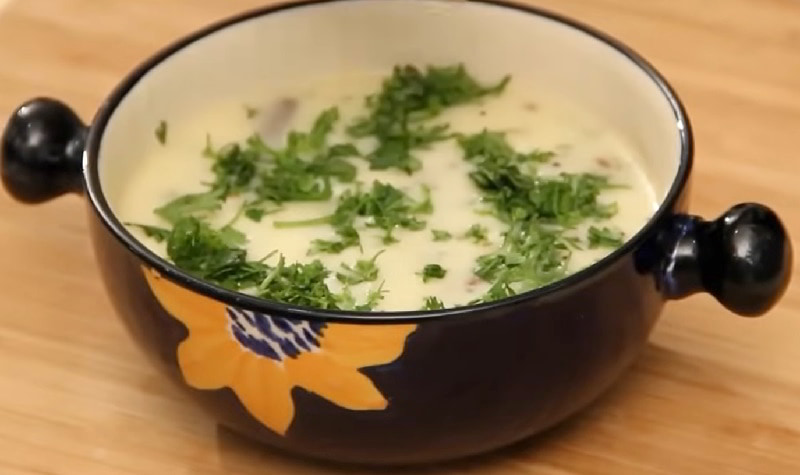
Gujarati kadhi stands as a distinctive version of this dish, renowned in Gujarati cuisine. This popular Gujarati delicacy is meticulously crafted using buttermilk or dahi and gram flour. An integral part of Gujarati culinary traditions, Gujarati kadhi distinguishes itself from its Rajasthani counterpart by its lighter consistency. To prepare, a mixture of curd and gram flour is liquefied with a few cups of water. Chopped green chilies, ginger, and asafoetida are sautéed in a pan on medium flame. Subsequently, the curd paste is introduced, heated, and stirred for a few minutes. The resulting kadhi is then served hot, forming a delectable pairing with khichdi, naan, chapati, or rice in the vibrant tapestry of Gujarati cuisine.
Puneri Misal
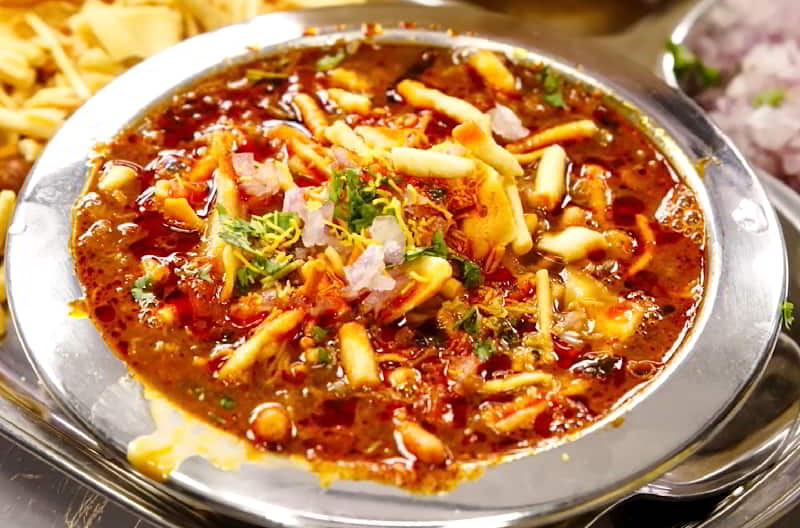
Puneri misal, a renowned vegetarian dish originating from Pune, Maharashtra, India, is often enjoyed for breakfast or as a midday snack, commonly served as part of misal pav. This dish maintains its popularity due to its simplicity, affordability, and nutritional value. Puneri misal offers a spectrum of flavors ranging from mild to spicy, making it a favorite street food. The dish comprises matki usal, tarry/kat/sample, potato bhaji, yogurt, chivda, farsan, garnished with onions, tomatoes, and coriander, arranged in multiple tiers. Served with sliced bread or a small loaf, known as misal-pav, the main highlight is the spicy curry called tarry or kat, adding a bold and fiery essence to the dish. Puneri misal, a less spicy variant, and dahi misal, enhanced with curd, further diversify the flavors and cater to different taste preferences.
Upsaaru
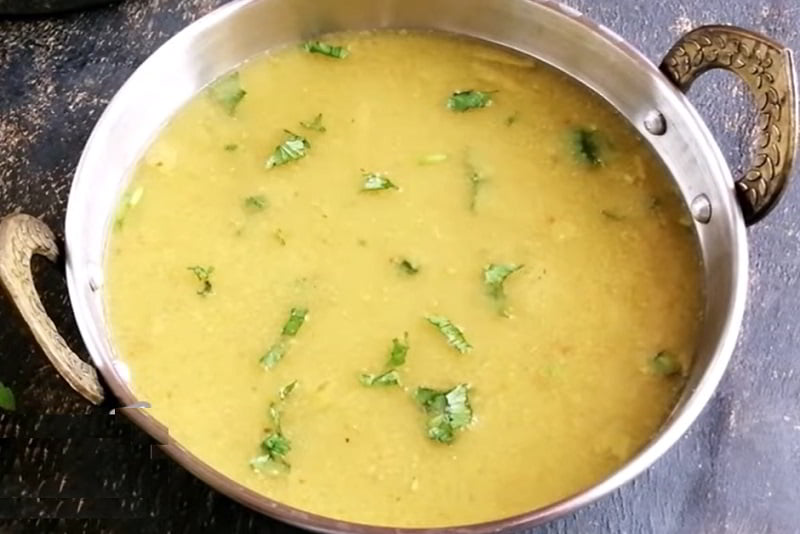
Upsaaru, or Uppesaru, is a variety of sambar prominent in South India, particularly in the southern region of Karnataka state. This traditional dish holds significance in South Karnataka. The name "Upsaaru" is derived from the combination of two words, "uppu" meaning salt and "saaru" meaning soup. The fundamental components of Upsaaru include salt, water, and a modest amount of chili powder. Its preparation dates back for an extended period in rural areas and is customarily consumed with Raagi mudde, a popular local dish. Upsaaru's simplicity and straightforward ingredients contribute to its enduring presence in South Indian culinary traditions, reflecting a connection to local heritage and flavors.
Keri No Ras

Keri no ras is a sweet and tangy mango pulp dish, commonly served as a side dish or dessert. The name "keri no ras" originates from its primary ingredient, ripe mangoes, known as "keri" in Gujarati. To craft this dish, ripe mangoes are peeled, and their pulp is extracted. The pulp is then blended with sugar, cardamom powder, and a hint of saffron, lending vibrant yellow hues and enhancing the flavor. Some variations may include the addition of milk or yogurt for creaminess. Typically served chilled, keri no ras is adorned with chopped nuts like almonds or pistachios. This refreshing and cooling treat is particularly relished during hot summer months, offering a delightful fusion of sweet and tangy mango goodness complemented by the aromatic notes of cardamom and saffron, solidifying its status as a beloved dish in India.
Vegetable Handva
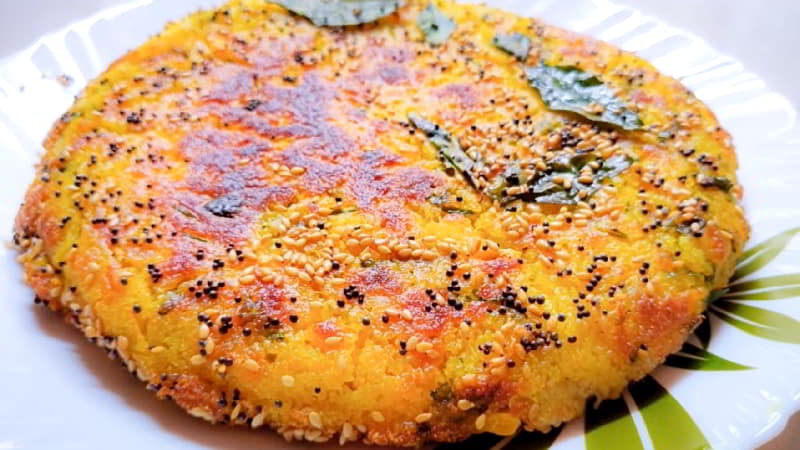
Vegetable handvo is a variation of the traditional handvo, a savory vegetable cake originating from Gujarat, India. This variant is crafted with gram flour as the base and incorporates a medley of vegetables, including peas and cabbage. To enhance its flavor profile, vegetable handvo is seasoned with garam masala, adding a warm and aromatic touch. This dish is known for its versatility and is often enjoyed as a wholesome and nutritious snack or meal. Typically, vegetable handvo is served alongside pickles or tea, offering a delightful combination of textures and flavors, making it a popular choice in Gujarati cuisine.
Galya Pulla
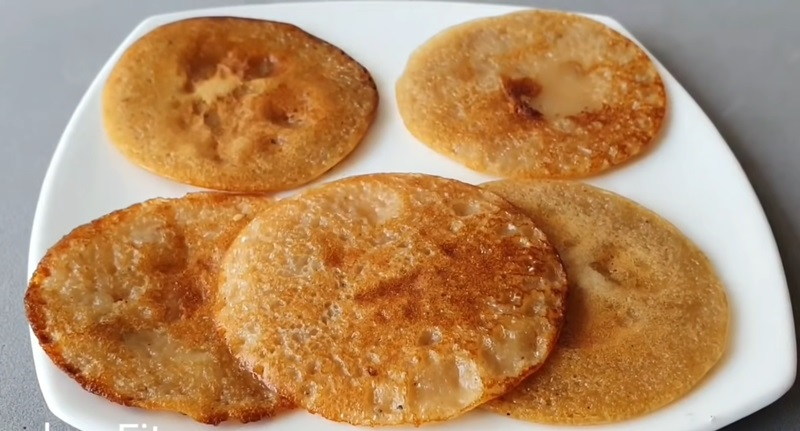
Galya pudla is a delectable food item prepared using jaggery and wheat flour. The process begins by melting jaggery in hot water, forming a sweetened liquid. Subsequently, wheat flour is combined with the melted jaggery, creating a caramel-like mixture. This blend is then spread on a tava and cooked, with ghee generously applied on both sides to enhance the flavors. Galya pudla embodies the rich sweetness of jaggery and the wholesome goodness of wheat flour, resulting in a delightful treat. This Gujarati dish is a testament to the region's culinary creativity, combining simple ingredients in a unique way to create a flavorful and satisfying culinary experience.
Narsobawadi Basundi
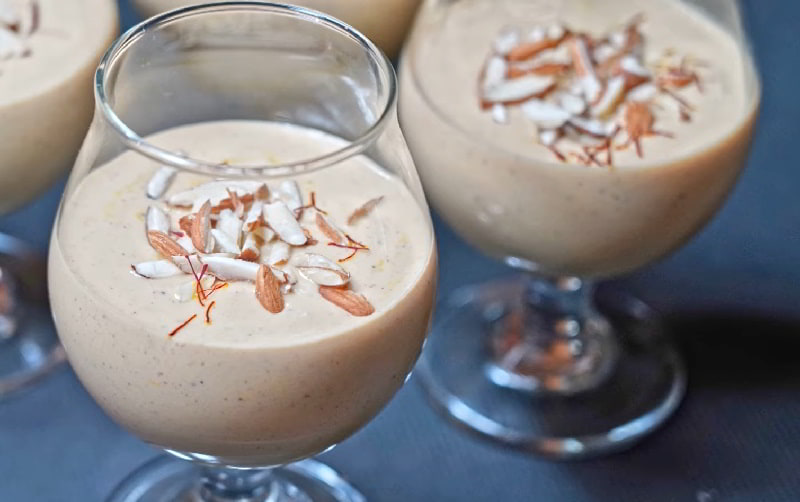
Narsobawadi Basundi is a regional variation of the classic Indian dessert Basundi, linked to the town of Narsobawadi in Maharashtra. This sweet and indulgent milk-based delicacy entails simmering milk to a rich consistency, sweetening it with sugar, and infusing it with the aromatic essence of cardamom or saffron. Unique to the culinary traditions of Narsobawadi, this variant may showcase distinctive preparation methods and incorporate additional local ingredients, adding a special touch that reflects the culinary heritage of the region. The name "Narsobawadi" implies a regional connection, suggesting that this particular Basundi holds cultural significance within the local community, offering a flavorful representation of Maharashtra's culinary diversity.






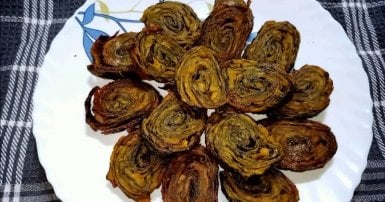
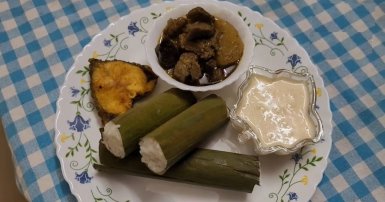
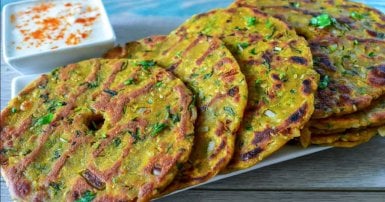
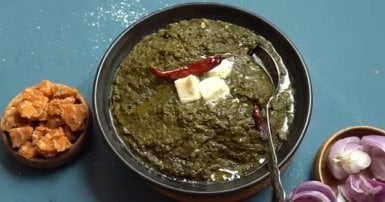
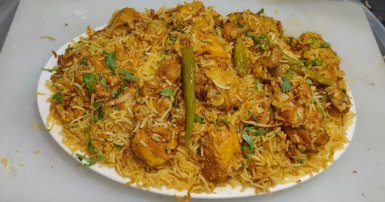
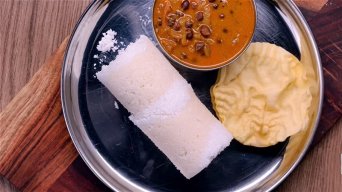

-1709813013.jpg)


